Contract Law: Formation and Vitiation
VerifiedAdded on 2020/02/19
|22
|5703
|40
AI Summary
This assignment delves into the core concepts of contract law, focusing on the process of contract formation and the concept of vitiation. Students are tasked with analyzing landmark cases such as Carlill v Carbolic Smoke Ball Company, Chappell & Co Ltd v Nestle Co Ltd, and Gibson v Manchester City Council to understand the principles of offer, acceptance, consideration, and how contracts can be rendered voidable due to factors like misrepresentation or undue influence. The provided resources include legal texts, case summaries from Swarb, and legislation.
Contribute Materials
Your contribution can guide someone’s learning journey. Share your
documents today.

deakin law school
Secure Best Marks with AI Grader
Need help grading? Try our AI Grader for instant feedback on your assignments.
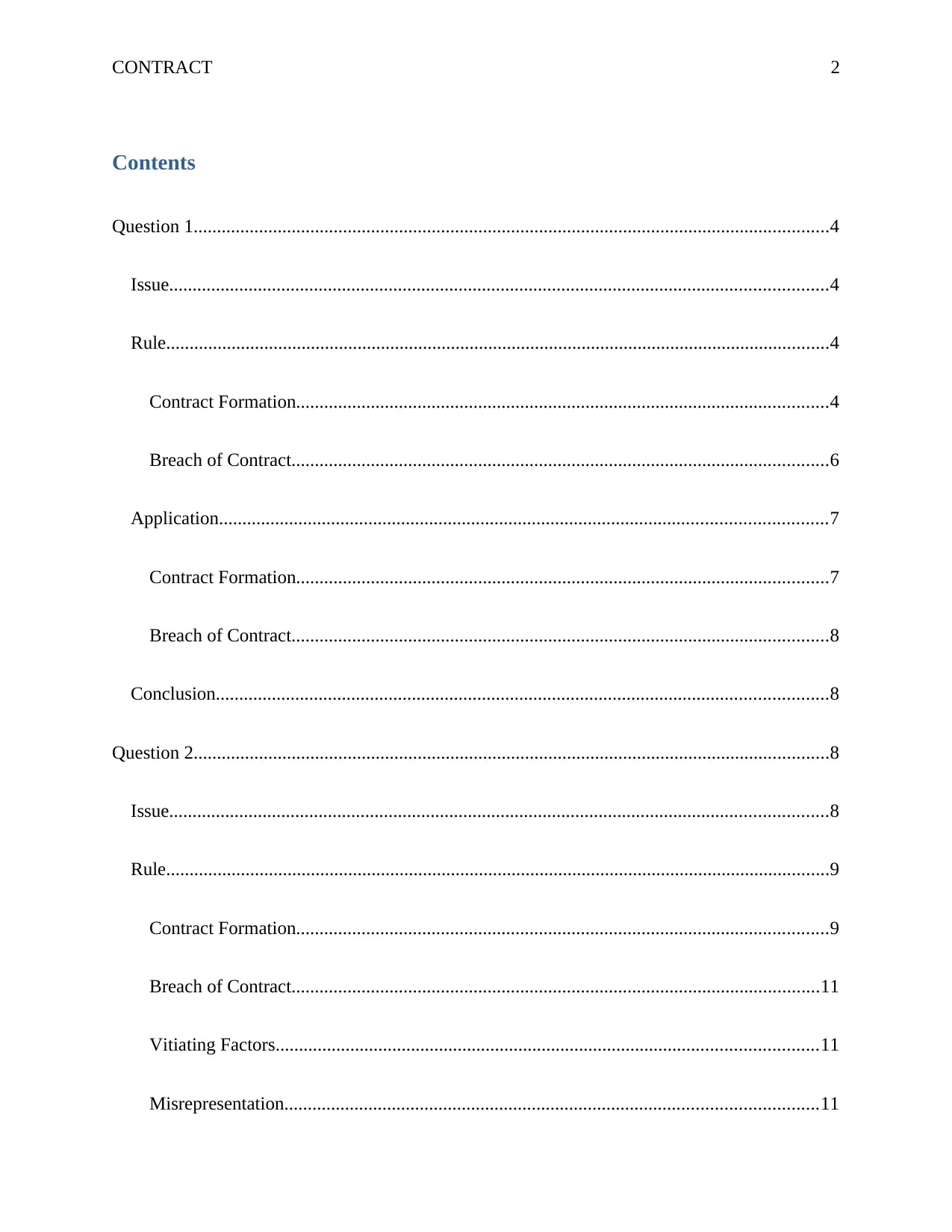
CONTRACT 2
Contents
Question 1........................................................................................................................................4
Issue.............................................................................................................................................4
Rule..............................................................................................................................................4
Contract Formation..................................................................................................................4
Breach of Contract...................................................................................................................6
Application..................................................................................................................................7
Contract Formation..................................................................................................................7
Breach of Contract...................................................................................................................8
Conclusion...................................................................................................................................8
Question 2........................................................................................................................................8
Issue.............................................................................................................................................8
Rule..............................................................................................................................................9
Contract Formation..................................................................................................................9
Breach of Contract.................................................................................................................11
Vitiating Factors....................................................................................................................11
Misrepresentation..................................................................................................................11
Contents
Question 1........................................................................................................................................4
Issue.............................................................................................................................................4
Rule..............................................................................................................................................4
Contract Formation..................................................................................................................4
Breach of Contract...................................................................................................................6
Application..................................................................................................................................7
Contract Formation..................................................................................................................7
Breach of Contract...................................................................................................................8
Conclusion...................................................................................................................................8
Question 2........................................................................................................................................8
Issue.............................................................................................................................................8
Rule..............................................................................................................................................9
Contract Formation..................................................................................................................9
Breach of Contract.................................................................................................................11
Vitiating Factors....................................................................................................................11
Misrepresentation..................................................................................................................11
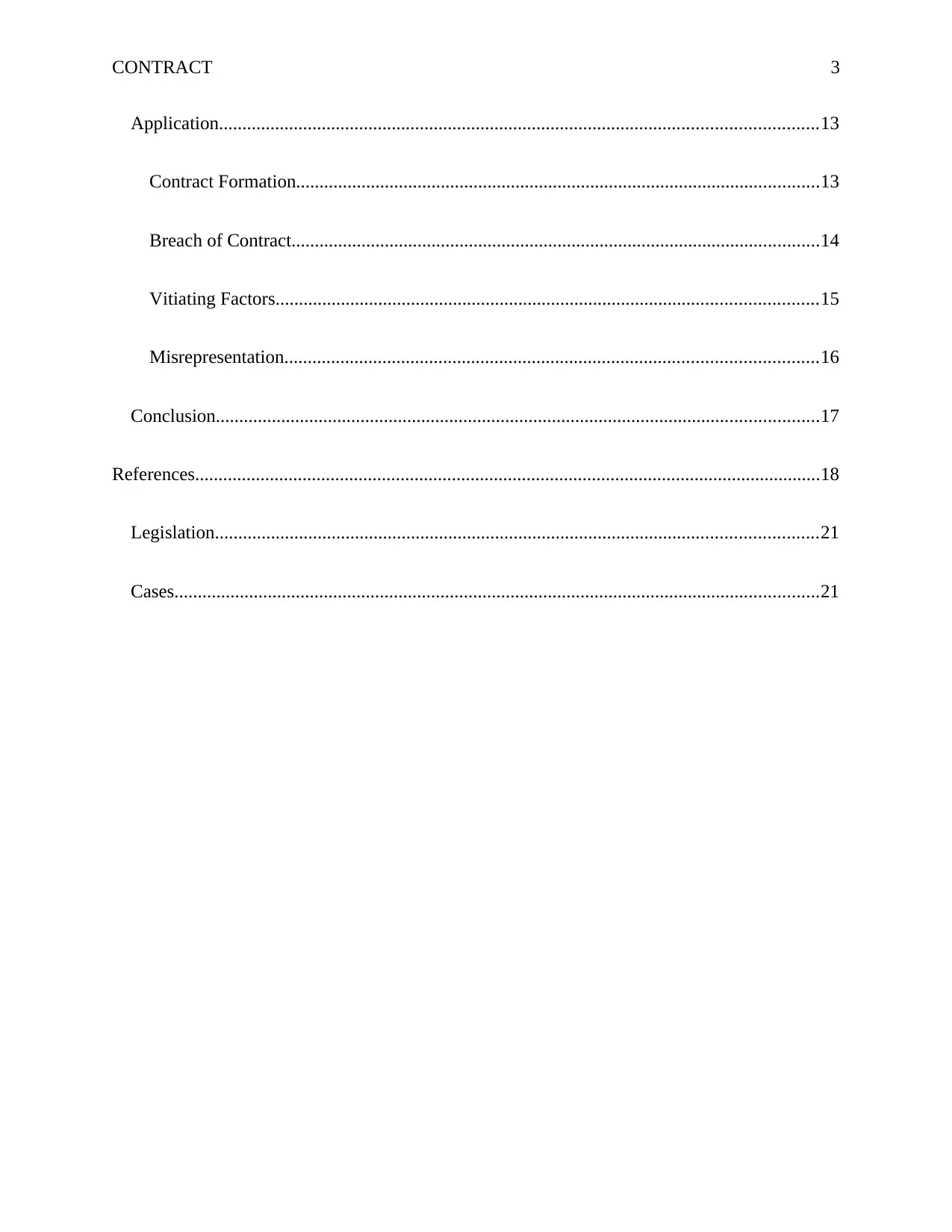
CONTRACT 3
Application................................................................................................................................13
Contract Formation................................................................................................................13
Breach of Contract.................................................................................................................14
Vitiating Factors....................................................................................................................15
Misrepresentation..................................................................................................................16
Conclusion.................................................................................................................................17
References......................................................................................................................................18
Legislation.................................................................................................................................21
Cases..........................................................................................................................................21
Application................................................................................................................................13
Contract Formation................................................................................................................13
Breach of Contract.................................................................................................................14
Vitiating Factors....................................................................................................................15
Misrepresentation..................................................................................................................16
Conclusion.................................................................................................................................17
References......................................................................................................................................18
Legislation.................................................................................................................................21
Cases..........................................................................................................................................21
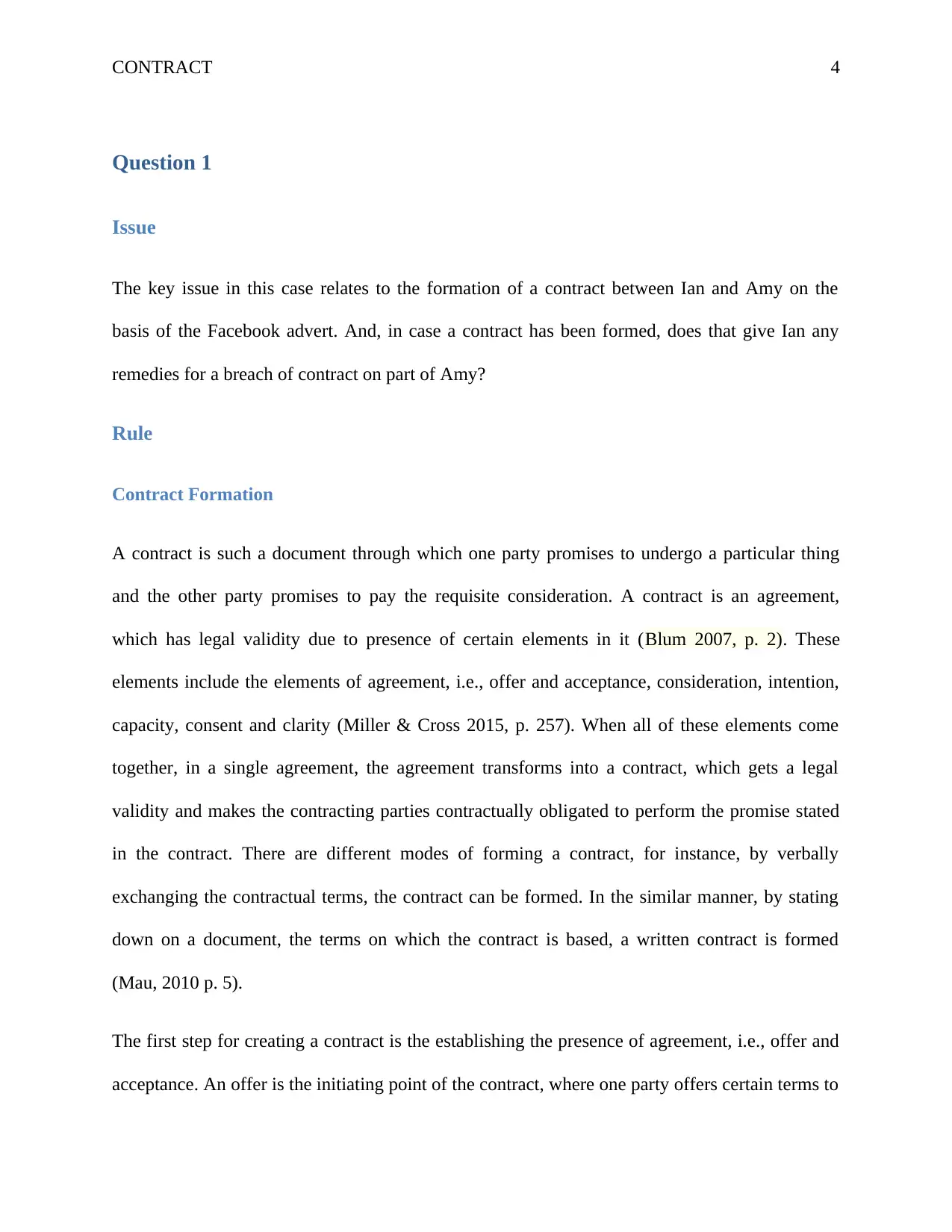
CONTRACT 4
Question 1
Issue
The key issue in this case relates to the formation of a contract between Ian and Amy on the
basis of the Facebook advert. And, in case a contract has been formed, does that give Ian any
remedies for a breach of contract on part of Amy?
Rule
Contract Formation
A contract is such a document through which one party promises to undergo a particular thing
and the other party promises to pay the requisite consideration. A contract is an agreement,
which has legal validity due to presence of certain elements in it (Blum 2007, p. 2). These
elements include the elements of agreement, i.e., offer and acceptance, consideration, intention,
capacity, consent and clarity (Miller & Cross 2015, p. 257). When all of these elements come
together, in a single agreement, the agreement transforms into a contract, which gets a legal
validity and makes the contracting parties contractually obligated to perform the promise stated
in the contract. There are different modes of forming a contract, for instance, by verbally
exchanging the contractual terms, the contract can be formed. In the similar manner, by stating
down on a document, the terms on which the contract is based, a written contract is formed
(Mau, 2010 p. 5).
The first step for creating a contract is the establishing the presence of agreement, i.e., offer and
acceptance. An offer is the initiating point of the contract, where one party offers certain terms to
Question 1
Issue
The key issue in this case relates to the formation of a contract between Ian and Amy on the
basis of the Facebook advert. And, in case a contract has been formed, does that give Ian any
remedies for a breach of contract on part of Amy?
Rule
Contract Formation
A contract is such a document through which one party promises to undergo a particular thing
and the other party promises to pay the requisite consideration. A contract is an agreement,
which has legal validity due to presence of certain elements in it (Blum 2007, p. 2). These
elements include the elements of agreement, i.e., offer and acceptance, consideration, intention,
capacity, consent and clarity (Miller & Cross 2015, p. 257). When all of these elements come
together, in a single agreement, the agreement transforms into a contract, which gets a legal
validity and makes the contracting parties contractually obligated to perform the promise stated
in the contract. There are different modes of forming a contract, for instance, by verbally
exchanging the contractual terms, the contract can be formed. In the similar manner, by stating
down on a document, the terms on which the contract is based, a written contract is formed
(Mau, 2010 p. 5).
The first step for creating a contract is the establishing the presence of agreement, i.e., offer and
acceptance. An offer is the initiating point of the contract, where one party offers certain terms to
Secure Best Marks with AI Grader
Need help grading? Try our AI Grader for instant feedback on your assignments.
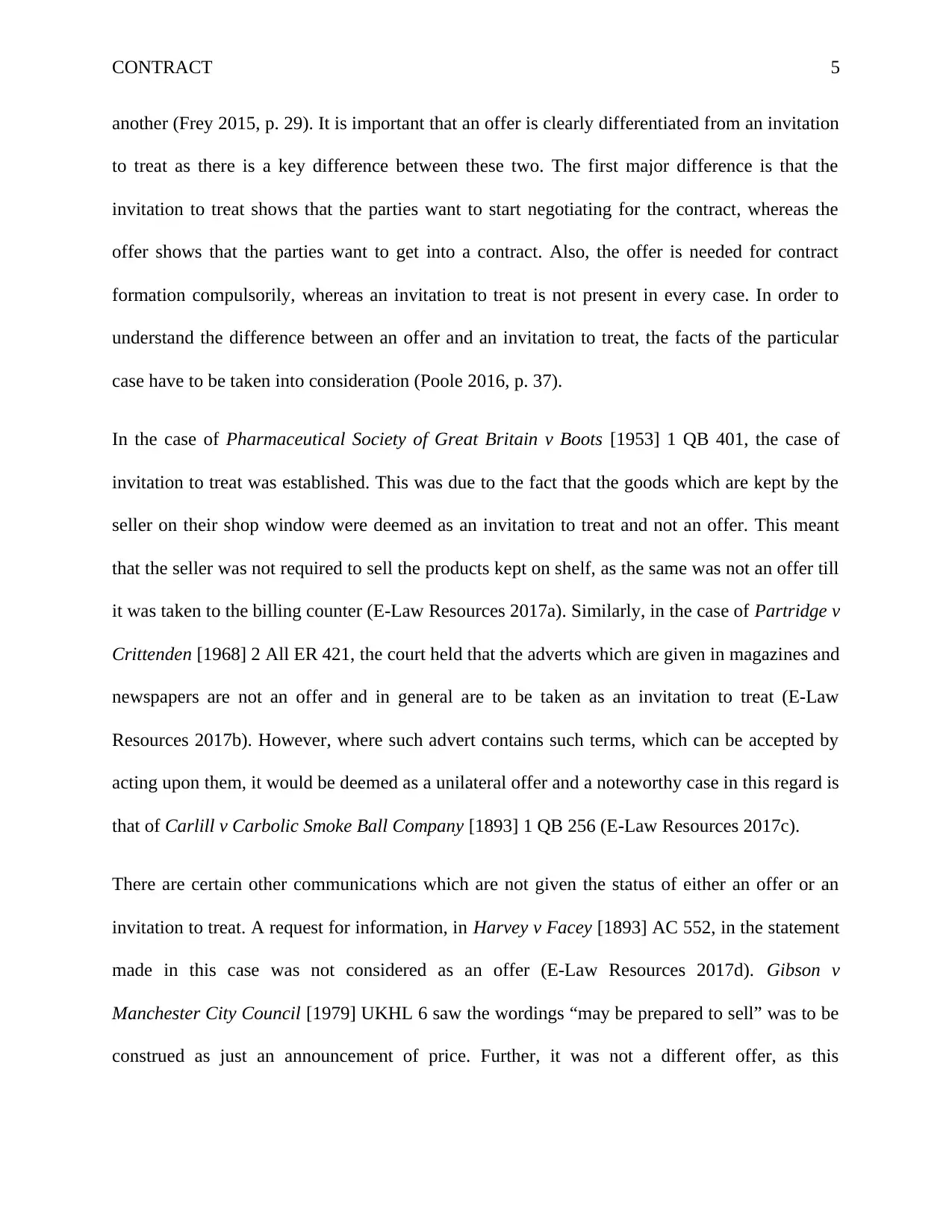
CONTRACT 5
another (Frey 2015, p. 29). It is important that an offer is clearly differentiated from an invitation
to treat as there is a key difference between these two. The first major difference is that the
invitation to treat shows that the parties want to start negotiating for the contract, whereas the
offer shows that the parties want to get into a contract. Also, the offer is needed for contract
formation compulsorily, whereas an invitation to treat is not present in every case. In order to
understand the difference between an offer and an invitation to treat, the facts of the particular
case have to be taken into consideration (Poole 2016, p. 37).
In the case of Pharmaceutical Society of Great Britain v Boots [1953] 1 QB 401, the case of
invitation to treat was established. This was due to the fact that the goods which are kept by the
seller on their shop window were deemed as an invitation to treat and not an offer. This meant
that the seller was not required to sell the products kept on shelf, as the same was not an offer till
it was taken to the billing counter (E-Law Resources 2017a). Similarly, in the case of Partridge v
Crittenden [1968] 2 All ER 421, the court held that the adverts which are given in magazines and
newspapers are not an offer and in general are to be taken as an invitation to treat (E-Law
Resources 2017b). However, where such advert contains such terms, which can be accepted by
acting upon them, it would be deemed as a unilateral offer and a noteworthy case in this regard is
that of Carlill v Carbolic Smoke Ball Company [1893] 1 QB 256 (E-Law Resources 2017c).
There are certain other communications which are not given the status of either an offer or an
invitation to treat. A request for information, in Harvey v Facey [1893] AC 552, in the statement
made in this case was not considered as an offer (E-Law Resources 2017d). Gibson v
Manchester City Council [1979] UKHL 6 saw the wordings “may be prepared to sell” was to be
construed as just an announcement of price. Further, it was not a different offer, as this
another (Frey 2015, p. 29). It is important that an offer is clearly differentiated from an invitation
to treat as there is a key difference between these two. The first major difference is that the
invitation to treat shows that the parties want to start negotiating for the contract, whereas the
offer shows that the parties want to get into a contract. Also, the offer is needed for contract
formation compulsorily, whereas an invitation to treat is not present in every case. In order to
understand the difference between an offer and an invitation to treat, the facts of the particular
case have to be taken into consideration (Poole 2016, p. 37).
In the case of Pharmaceutical Society of Great Britain v Boots [1953] 1 QB 401, the case of
invitation to treat was established. This was due to the fact that the goods which are kept by the
seller on their shop window were deemed as an invitation to treat and not an offer. This meant
that the seller was not required to sell the products kept on shelf, as the same was not an offer till
it was taken to the billing counter (E-Law Resources 2017a). Similarly, in the case of Partridge v
Crittenden [1968] 2 All ER 421, the court held that the adverts which are given in magazines and
newspapers are not an offer and in general are to be taken as an invitation to treat (E-Law
Resources 2017b). However, where such advert contains such terms, which can be accepted by
acting upon them, it would be deemed as a unilateral offer and a noteworthy case in this regard is
that of Carlill v Carbolic Smoke Ball Company [1893] 1 QB 256 (E-Law Resources 2017c).
There are certain other communications which are not given the status of either an offer or an
invitation to treat. A request for information, in Harvey v Facey [1893] AC 552, in the statement
made in this case was not considered as an offer (E-Law Resources 2017d). Gibson v
Manchester City Council [1979] UKHL 6 saw the wordings “may be prepared to sell” was to be
construed as just an announcement of price. Further, it was not a different offer, as this
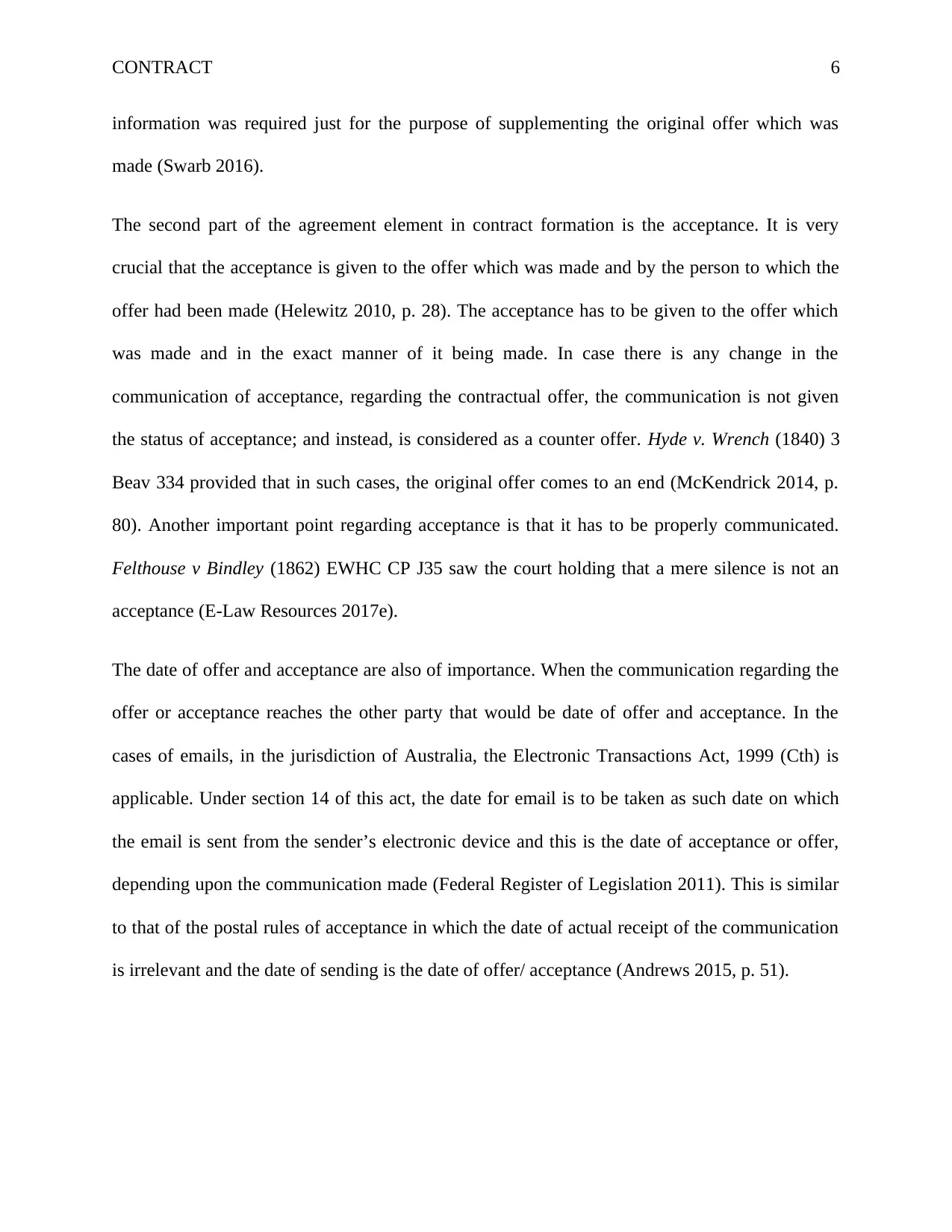
CONTRACT 6
information was required just for the purpose of supplementing the original offer which was
made (Swarb 2016).
The second part of the agreement element in contract formation is the acceptance. It is very
crucial that the acceptance is given to the offer which was made and by the person to which the
offer had been made (Helewitz 2010, p. 28). The acceptance has to be given to the offer which
was made and in the exact manner of it being made. In case there is any change in the
communication of acceptance, regarding the contractual offer, the communication is not given
the status of acceptance; and instead, is considered as a counter offer. Hyde v. Wrench (1840) 3
Beav 334 provided that in such cases, the original offer comes to an end (McKendrick 2014, p.
80). Another important point regarding acceptance is that it has to be properly communicated.
Felthouse v Bindley (1862) EWHC CP J35 saw the court holding that a mere silence is not an
acceptance (E-Law Resources 2017e).
The date of offer and acceptance are also of importance. When the communication regarding the
offer or acceptance reaches the other party that would be date of offer and acceptance. In the
cases of emails, in the jurisdiction of Australia, the Electronic Transactions Act, 1999 (Cth) is
applicable. Under section 14 of this act, the date for email is to be taken as such date on which
the email is sent from the sender’s electronic device and this is the date of acceptance or offer,
depending upon the communication made (Federal Register of Legislation 2011). This is similar
to that of the postal rules of acceptance in which the date of actual receipt of the communication
is irrelevant and the date of sending is the date of offer/ acceptance (Andrews 2015, p. 51).
information was required just for the purpose of supplementing the original offer which was
made (Swarb 2016).
The second part of the agreement element in contract formation is the acceptance. It is very
crucial that the acceptance is given to the offer which was made and by the person to which the
offer had been made (Helewitz 2010, p. 28). The acceptance has to be given to the offer which
was made and in the exact manner of it being made. In case there is any change in the
communication of acceptance, regarding the contractual offer, the communication is not given
the status of acceptance; and instead, is considered as a counter offer. Hyde v. Wrench (1840) 3
Beav 334 provided that in such cases, the original offer comes to an end (McKendrick 2014, p.
80). Another important point regarding acceptance is that it has to be properly communicated.
Felthouse v Bindley (1862) EWHC CP J35 saw the court holding that a mere silence is not an
acceptance (E-Law Resources 2017e).
The date of offer and acceptance are also of importance. When the communication regarding the
offer or acceptance reaches the other party that would be date of offer and acceptance. In the
cases of emails, in the jurisdiction of Australia, the Electronic Transactions Act, 1999 (Cth) is
applicable. Under section 14 of this act, the date for email is to be taken as such date on which
the email is sent from the sender’s electronic device and this is the date of acceptance or offer,
depending upon the communication made (Federal Register of Legislation 2011). This is similar
to that of the postal rules of acceptance in which the date of actual receipt of the communication
is irrelevant and the date of sending is the date of offer/ acceptance (Andrews 2015, p. 51).
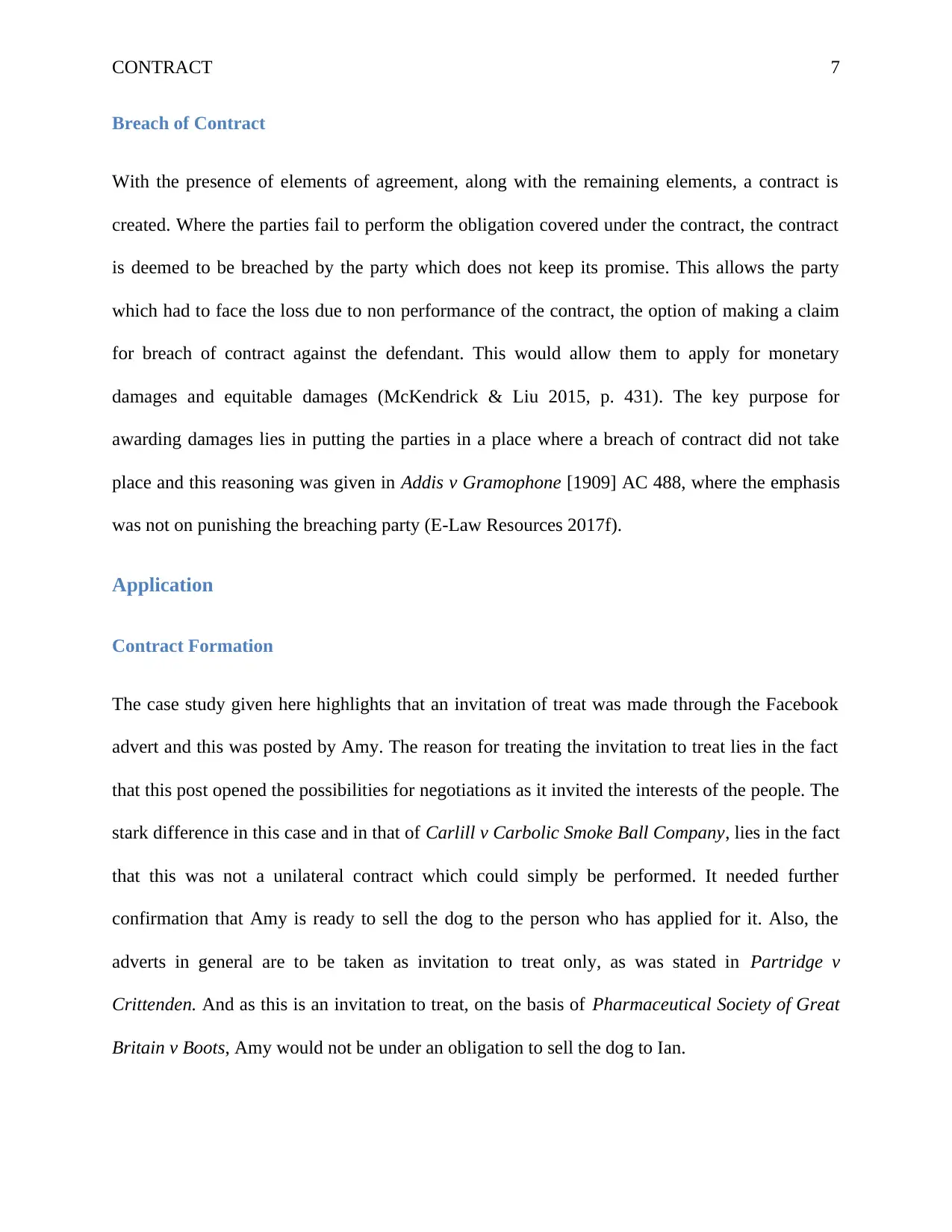
CONTRACT 7
Breach of Contract
With the presence of elements of agreement, along with the remaining elements, a contract is
created. Where the parties fail to perform the obligation covered under the contract, the contract
is deemed to be breached by the party which does not keep its promise. This allows the party
which had to face the loss due to non performance of the contract, the option of making a claim
for breach of contract against the defendant. This would allow them to apply for monetary
damages and equitable damages (McKendrick & Liu 2015, p. 431). The key purpose for
awarding damages lies in putting the parties in a place where a breach of contract did not take
place and this reasoning was given in Addis v Gramophone [1909] AC 488, where the emphasis
was not on punishing the breaching party (E-Law Resources 2017f).
Application
Contract Formation
The case study given here highlights that an invitation of treat was made through the Facebook
advert and this was posted by Amy. The reason for treating the invitation to treat lies in the fact
that this post opened the possibilities for negotiations as it invited the interests of the people. The
stark difference in this case and in that of Carlill v Carbolic Smoke Ball Company, lies in the fact
that this was not a unilateral contract which could simply be performed. It needed further
confirmation that Amy is ready to sell the dog to the person who has applied for it. Also, the
adverts in general are to be taken as invitation to treat only, as was stated in Partridge v
Crittenden. And as this is an invitation to treat, on the basis of Pharmaceutical Society of Great
Britain v Boots, Amy would not be under an obligation to sell the dog to Ian.
Breach of Contract
With the presence of elements of agreement, along with the remaining elements, a contract is
created. Where the parties fail to perform the obligation covered under the contract, the contract
is deemed to be breached by the party which does not keep its promise. This allows the party
which had to face the loss due to non performance of the contract, the option of making a claim
for breach of contract against the defendant. This would allow them to apply for monetary
damages and equitable damages (McKendrick & Liu 2015, p. 431). The key purpose for
awarding damages lies in putting the parties in a place where a breach of contract did not take
place and this reasoning was given in Addis v Gramophone [1909] AC 488, where the emphasis
was not on punishing the breaching party (E-Law Resources 2017f).
Application
Contract Formation
The case study given here highlights that an invitation of treat was made through the Facebook
advert and this was posted by Amy. The reason for treating the invitation to treat lies in the fact
that this post opened the possibilities for negotiations as it invited the interests of the people. The
stark difference in this case and in that of Carlill v Carbolic Smoke Ball Company, lies in the fact
that this was not a unilateral contract which could simply be performed. It needed further
confirmation that Amy is ready to sell the dog to the person who has applied for it. Also, the
adverts in general are to be taken as invitation to treat only, as was stated in Partridge v
Crittenden. And as this is an invitation to treat, on the basis of Pharmaceutical Society of Great
Britain v Boots, Amy would not be under an obligation to sell the dog to Ian.
Paraphrase This Document
Need a fresh take? Get an instant paraphrase of this document with our AI Paraphraser
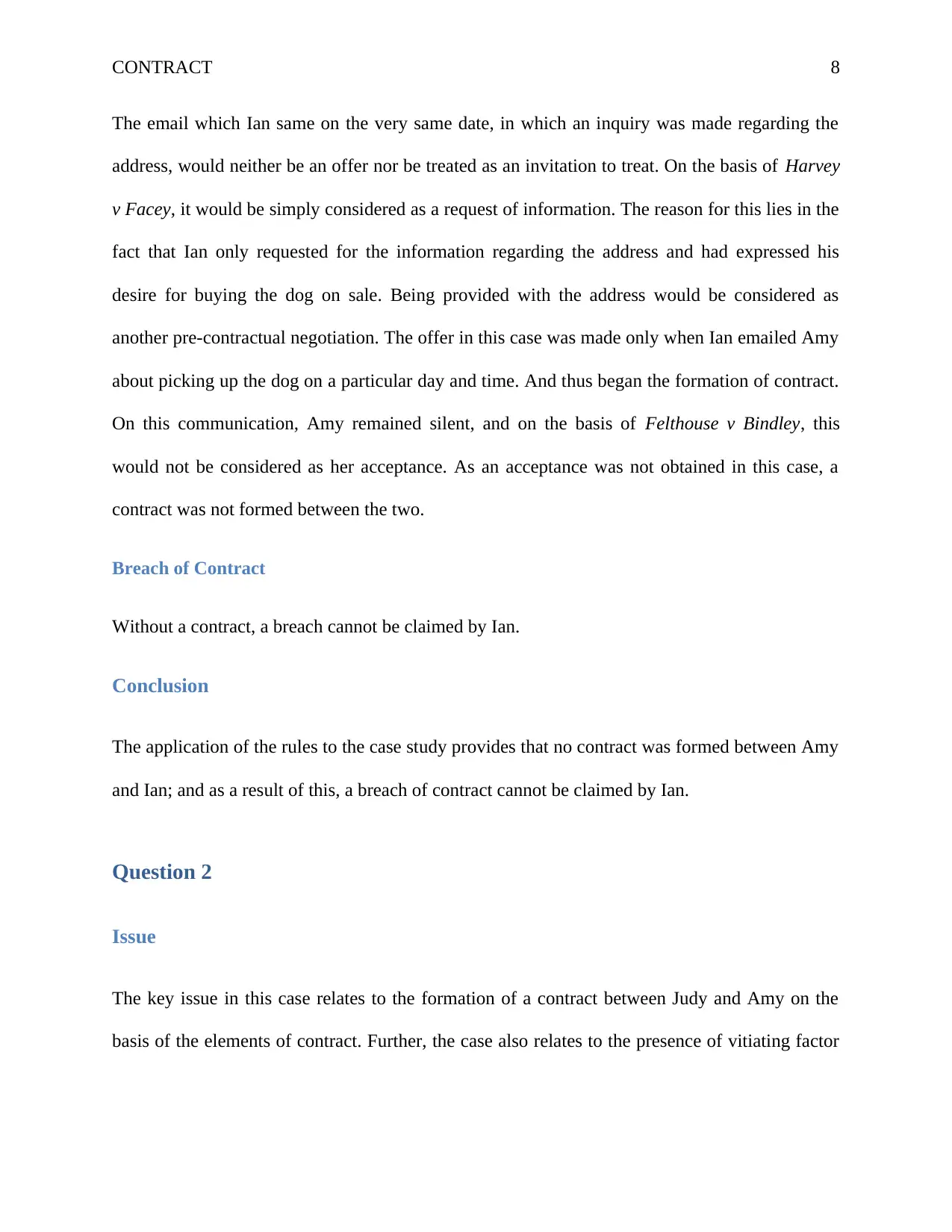
CONTRACT 8
The email which Ian same on the very same date, in which an inquiry was made regarding the
address, would neither be an offer nor be treated as an invitation to treat. On the basis of Harvey
v Facey, it would be simply considered as a request of information. The reason for this lies in the
fact that Ian only requested for the information regarding the address and had expressed his
desire for buying the dog on sale. Being provided with the address would be considered as
another pre-contractual negotiation. The offer in this case was made only when Ian emailed Amy
about picking up the dog on a particular day and time. And thus began the formation of contract.
On this communication, Amy remained silent, and on the basis of Felthouse v Bindley, this
would not be considered as her acceptance. As an acceptance was not obtained in this case, a
contract was not formed between the two.
Breach of Contract
Without a contract, a breach cannot be claimed by Ian.
Conclusion
The application of the rules to the case study provides that no contract was formed between Amy
and Ian; and as a result of this, a breach of contract cannot be claimed by Ian.
Question 2
Issue
The key issue in this case relates to the formation of a contract between Judy and Amy on the
basis of the elements of contract. Further, the case also relates to the presence of vitiating factor
The email which Ian same on the very same date, in which an inquiry was made regarding the
address, would neither be an offer nor be treated as an invitation to treat. On the basis of Harvey
v Facey, it would be simply considered as a request of information. The reason for this lies in the
fact that Ian only requested for the information regarding the address and had expressed his
desire for buying the dog on sale. Being provided with the address would be considered as
another pre-contractual negotiation. The offer in this case was made only when Ian emailed Amy
about picking up the dog on a particular day and time. And thus began the formation of contract.
On this communication, Amy remained silent, and on the basis of Felthouse v Bindley, this
would not be considered as her acceptance. As an acceptance was not obtained in this case, a
contract was not formed between the two.
Breach of Contract
Without a contract, a breach cannot be claimed by Ian.
Conclusion
The application of the rules to the case study provides that no contract was formed between Amy
and Ian; and as a result of this, a breach of contract cannot be claimed by Ian.
Question 2
Issue
The key issue in this case relates to the formation of a contract between Judy and Amy on the
basis of the elements of contract. Further, the case also relates to the presence of vitiating factor
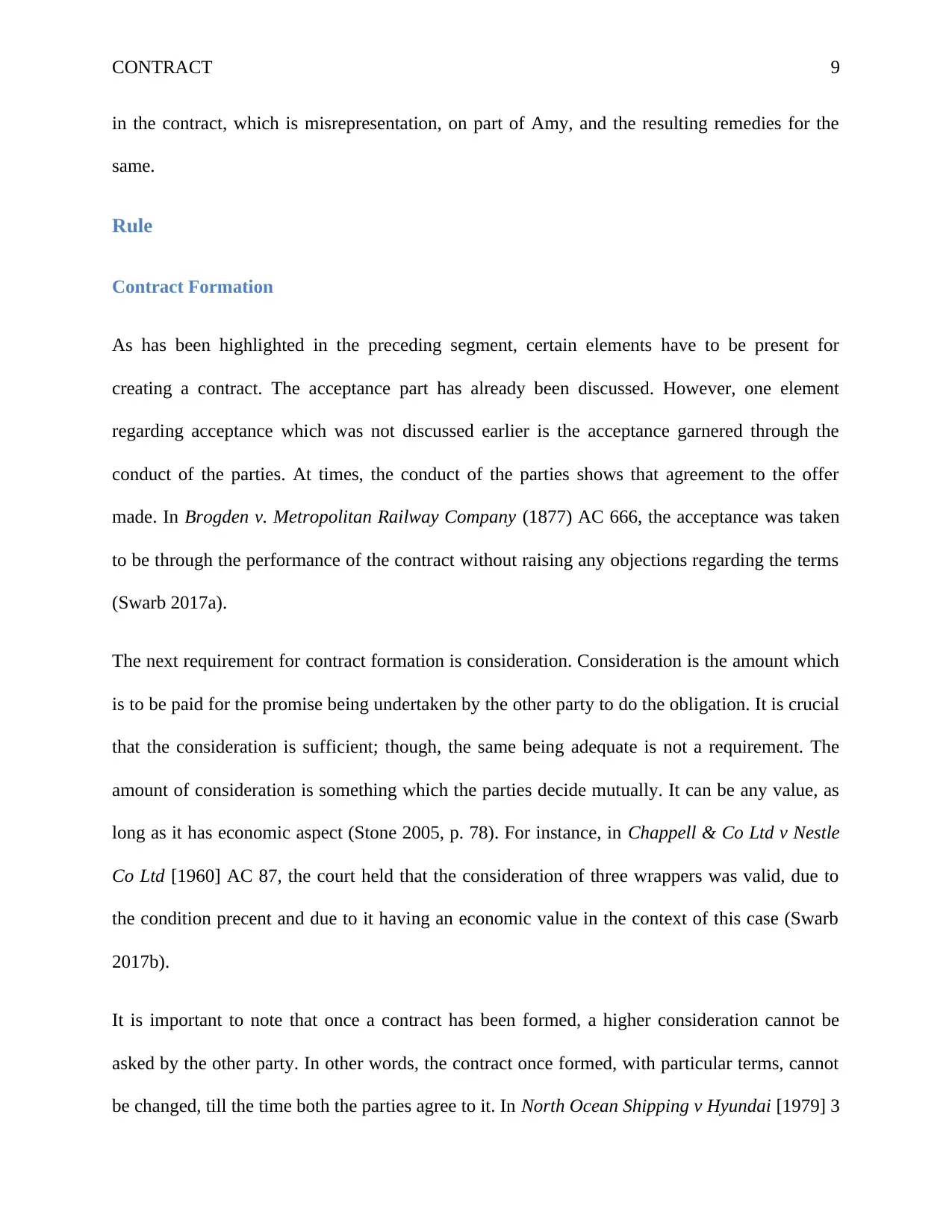
CONTRACT 9
in the contract, which is misrepresentation, on part of Amy, and the resulting remedies for the
same.
Rule
Contract Formation
As has been highlighted in the preceding segment, certain elements have to be present for
creating a contract. The acceptance part has already been discussed. However, one element
regarding acceptance which was not discussed earlier is the acceptance garnered through the
conduct of the parties. At times, the conduct of the parties shows that agreement to the offer
made. In Brogden v. Metropolitan Railway Company (1877) AC 666, the acceptance was taken
to be through the performance of the contract without raising any objections regarding the terms
(Swarb 2017a).
The next requirement for contract formation is consideration. Consideration is the amount which
is to be paid for the promise being undertaken by the other party to do the obligation. It is crucial
that the consideration is sufficient; though, the same being adequate is not a requirement. The
amount of consideration is something which the parties decide mutually. It can be any value, as
long as it has economic aspect (Stone 2005, p. 78). For instance, in Chappell & Co Ltd v Nestle
Co Ltd [1960] AC 87, the court held that the consideration of three wrappers was valid, due to
the condition precent and due to it having an economic value in the context of this case (Swarb
2017b).
It is important to note that once a contract has been formed, a higher consideration cannot be
asked by the other party. In other words, the contract once formed, with particular terms, cannot
be changed, till the time both the parties agree to it. In North Ocean Shipping v Hyundai [1979] 3
in the contract, which is misrepresentation, on part of Amy, and the resulting remedies for the
same.
Rule
Contract Formation
As has been highlighted in the preceding segment, certain elements have to be present for
creating a contract. The acceptance part has already been discussed. However, one element
regarding acceptance which was not discussed earlier is the acceptance garnered through the
conduct of the parties. At times, the conduct of the parties shows that agreement to the offer
made. In Brogden v. Metropolitan Railway Company (1877) AC 666, the acceptance was taken
to be through the performance of the contract without raising any objections regarding the terms
(Swarb 2017a).
The next requirement for contract formation is consideration. Consideration is the amount which
is to be paid for the promise being undertaken by the other party to do the obligation. It is crucial
that the consideration is sufficient; though, the same being adequate is not a requirement. The
amount of consideration is something which the parties decide mutually. It can be any value, as
long as it has economic aspect (Stone 2005, p. 78). For instance, in Chappell & Co Ltd v Nestle
Co Ltd [1960] AC 87, the court held that the consideration of three wrappers was valid, due to
the condition precent and due to it having an economic value in the context of this case (Swarb
2017b).
It is important to note that once a contract has been formed, a higher consideration cannot be
asked by the other party. In other words, the contract once formed, with particular terms, cannot
be changed, till the time both the parties agree to it. In North Ocean Shipping v Hyundai [1979] 3
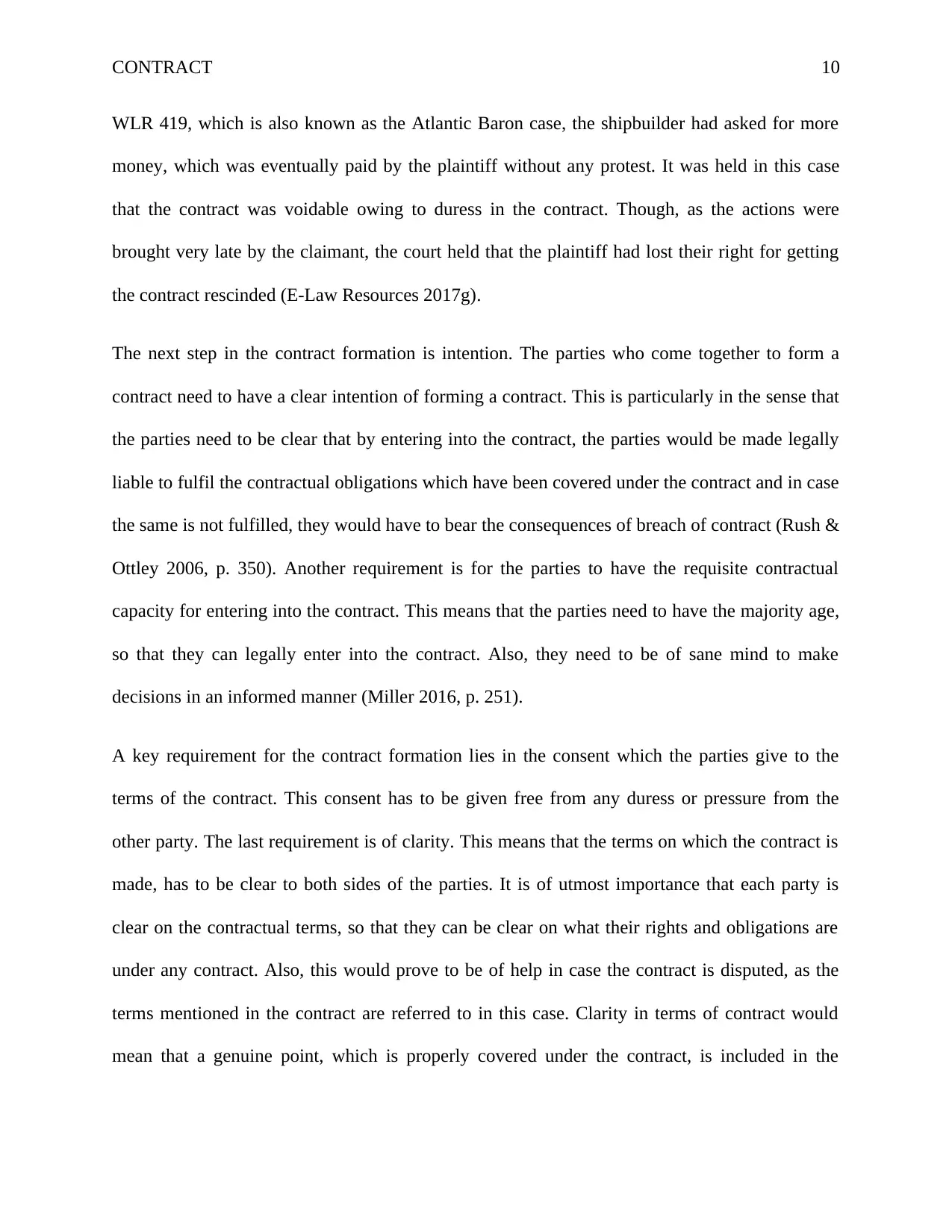
CONTRACT 10
WLR 419, which is also known as the Atlantic Baron case, the shipbuilder had asked for more
money, which was eventually paid by the plaintiff without any protest. It was held in this case
that the contract was voidable owing to duress in the contract. Though, as the actions were
brought very late by the claimant, the court held that the plaintiff had lost their right for getting
the contract rescinded (E-Law Resources 2017g).
The next step in the contract formation is intention. The parties who come together to form a
contract need to have a clear intention of forming a contract. This is particularly in the sense that
the parties need to be clear that by entering into the contract, the parties would be made legally
liable to fulfil the contractual obligations which have been covered under the contract and in case
the same is not fulfilled, they would have to bear the consequences of breach of contract (Rush &
Ottley 2006, p. 350). Another requirement is for the parties to have the requisite contractual
capacity for entering into the contract. This means that the parties need to have the majority age,
so that they can legally enter into the contract. Also, they need to be of sane mind to make
decisions in an informed manner (Miller 2016, p. 251).
A key requirement for the contract formation lies in the consent which the parties give to the
terms of the contract. This consent has to be given free from any duress or pressure from the
other party. The last requirement is of clarity. This means that the terms on which the contract is
made, has to be clear to both sides of the parties. It is of utmost importance that each party is
clear on the contractual terms, so that they can be clear on what their rights and obligations are
under any contract. Also, this would prove to be of help in case the contract is disputed, as the
terms mentioned in the contract are referred to in this case. Clarity in terms of contract would
mean that a genuine point, which is properly covered under the contract, is included in the
WLR 419, which is also known as the Atlantic Baron case, the shipbuilder had asked for more
money, which was eventually paid by the plaintiff without any protest. It was held in this case
that the contract was voidable owing to duress in the contract. Though, as the actions were
brought very late by the claimant, the court held that the plaintiff had lost their right for getting
the contract rescinded (E-Law Resources 2017g).
The next step in the contract formation is intention. The parties who come together to form a
contract need to have a clear intention of forming a contract. This is particularly in the sense that
the parties need to be clear that by entering into the contract, the parties would be made legally
liable to fulfil the contractual obligations which have been covered under the contract and in case
the same is not fulfilled, they would have to bear the consequences of breach of contract (Rush &
Ottley 2006, p. 350). Another requirement is for the parties to have the requisite contractual
capacity for entering into the contract. This means that the parties need to have the majority age,
so that they can legally enter into the contract. Also, they need to be of sane mind to make
decisions in an informed manner (Miller 2016, p. 251).
A key requirement for the contract formation lies in the consent which the parties give to the
terms of the contract. This consent has to be given free from any duress or pressure from the
other party. The last requirement is of clarity. This means that the terms on which the contract is
made, has to be clear to both sides of the parties. It is of utmost importance that each party is
clear on the contractual terms, so that they can be clear on what their rights and obligations are
under any contract. Also, this would prove to be of help in case the contract is disputed, as the
terms mentioned in the contract are referred to in this case. Clarity in terms of contract would
mean that a genuine point, which is properly covered under the contract, is included in the
Secure Best Marks with AI Grader
Need help grading? Try our AI Grader for instant feedback on your assignments.
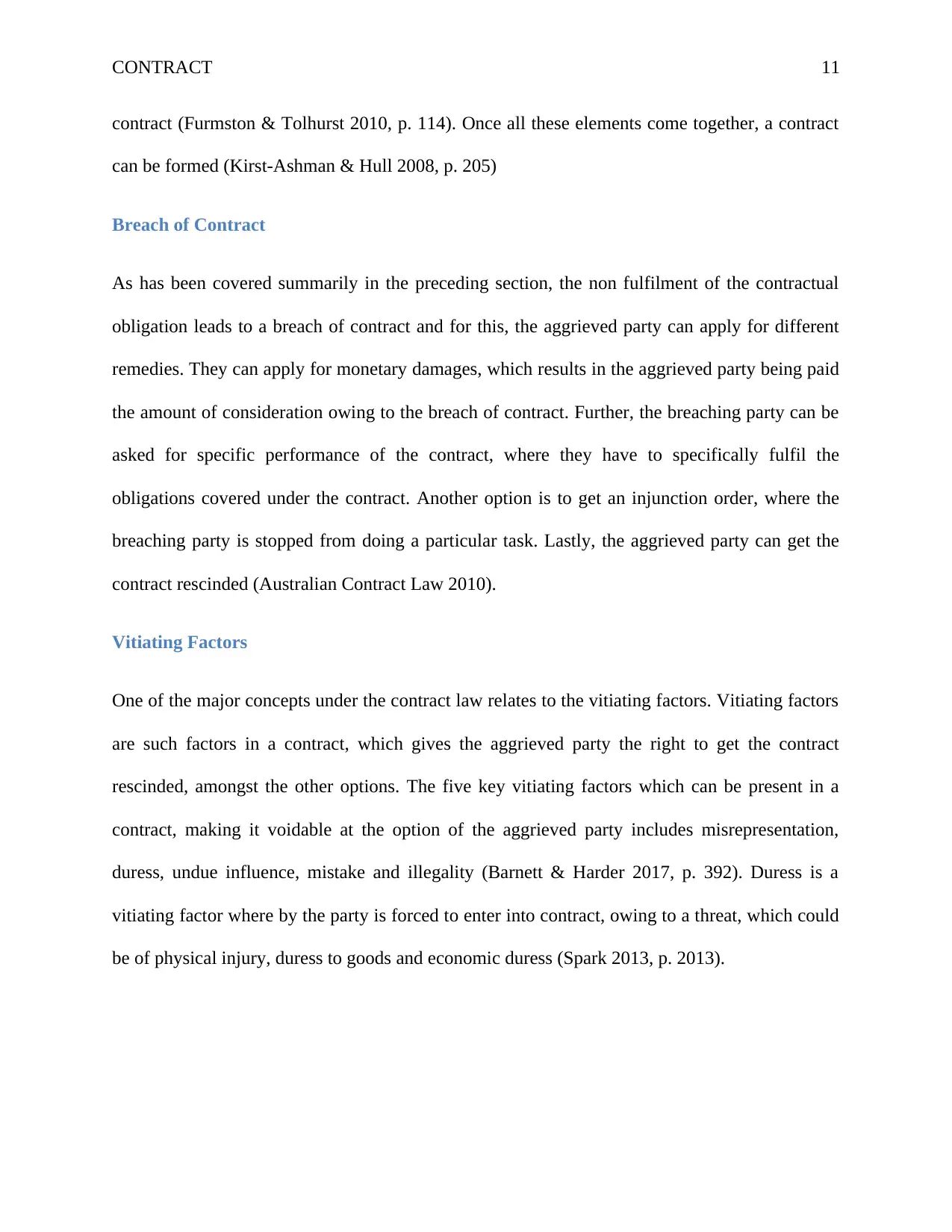
CONTRACT 11
contract (Furmston & Tolhurst 2010, p. 114). Once all these elements come together, a contract
can be formed (Kirst-Ashman & Hull 2008, p. 205)
Breach of Contract
As has been covered summarily in the preceding section, the non fulfilment of the contractual
obligation leads to a breach of contract and for this, the aggrieved party can apply for different
remedies. They can apply for monetary damages, which results in the aggrieved party being paid
the amount of consideration owing to the breach of contract. Further, the breaching party can be
asked for specific performance of the contract, where they have to specifically fulfil the
obligations covered under the contract. Another option is to get an injunction order, where the
breaching party is stopped from doing a particular task. Lastly, the aggrieved party can get the
contract rescinded (Australian Contract Law 2010).
Vitiating Factors
One of the major concepts under the contract law relates to the vitiating factors. Vitiating factors
are such factors in a contract, which gives the aggrieved party the right to get the contract
rescinded, amongst the other options. The five key vitiating factors which can be present in a
contract, making it voidable at the option of the aggrieved party includes misrepresentation,
duress, undue influence, mistake and illegality (Barnett & Harder 2017, p. 392). Duress is a
vitiating factor where by the party is forced to enter into contract, owing to a threat, which could
be of physical injury, duress to goods and economic duress (Spark 2013, p. 2013).
contract (Furmston & Tolhurst 2010, p. 114). Once all these elements come together, a contract
can be formed (Kirst-Ashman & Hull 2008, p. 205)
Breach of Contract
As has been covered summarily in the preceding section, the non fulfilment of the contractual
obligation leads to a breach of contract and for this, the aggrieved party can apply for different
remedies. They can apply for monetary damages, which results in the aggrieved party being paid
the amount of consideration owing to the breach of contract. Further, the breaching party can be
asked for specific performance of the contract, where they have to specifically fulfil the
obligations covered under the contract. Another option is to get an injunction order, where the
breaching party is stopped from doing a particular task. Lastly, the aggrieved party can get the
contract rescinded (Australian Contract Law 2010).
Vitiating Factors
One of the major concepts under the contract law relates to the vitiating factors. Vitiating factors
are such factors in a contract, which gives the aggrieved party the right to get the contract
rescinded, amongst the other options. The five key vitiating factors which can be present in a
contract, making it voidable at the option of the aggrieved party includes misrepresentation,
duress, undue influence, mistake and illegality (Barnett & Harder 2017, p. 392). Duress is a
vitiating factor where by the party is forced to enter into contract, owing to a threat, which could
be of physical injury, duress to goods and economic duress (Spark 2013, p. 2013).
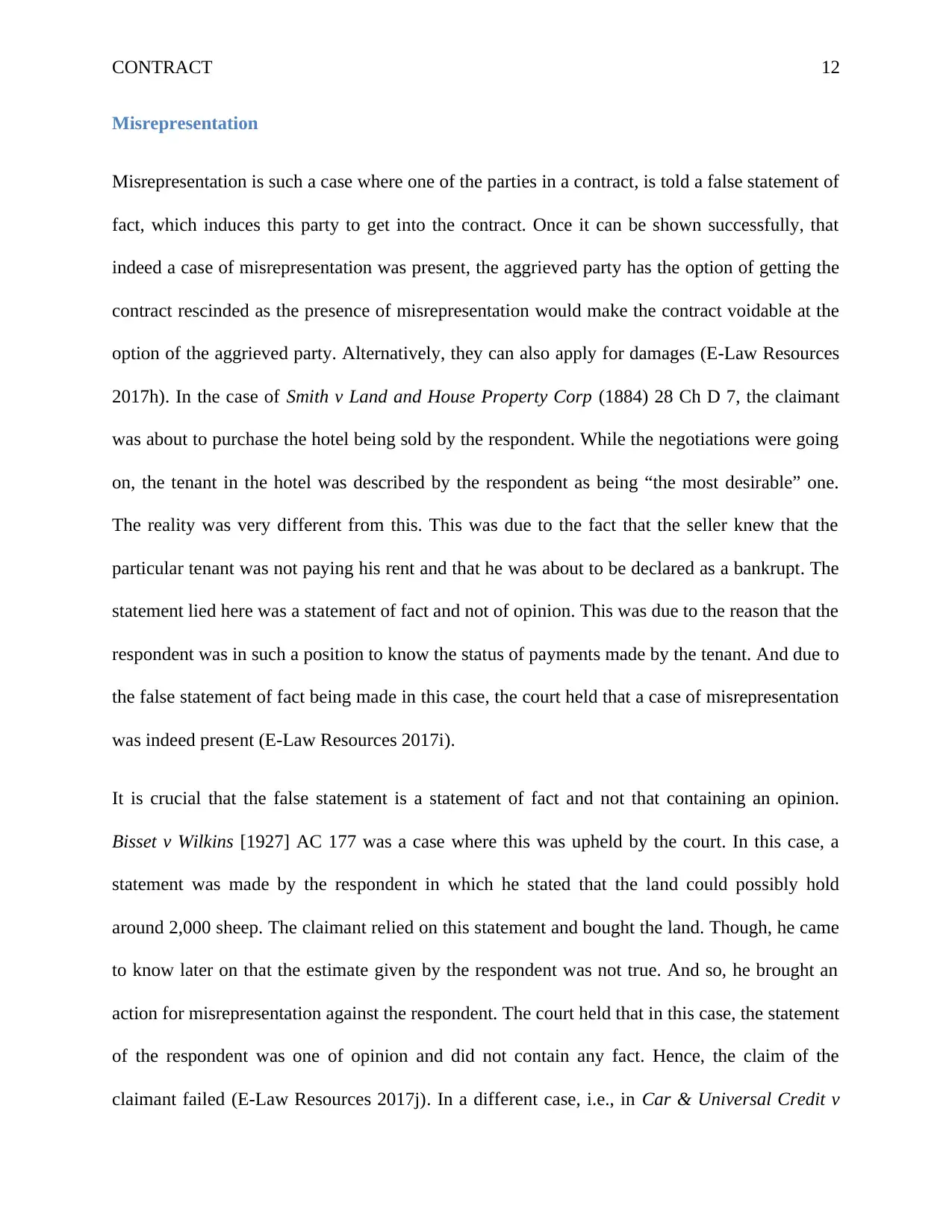
CONTRACT 12
Misrepresentation
Misrepresentation is such a case where one of the parties in a contract, is told a false statement of
fact, which induces this party to get into the contract. Once it can be shown successfully, that
indeed a case of misrepresentation was present, the aggrieved party has the option of getting the
contract rescinded as the presence of misrepresentation would make the contract voidable at the
option of the aggrieved party. Alternatively, they can also apply for damages (E-Law Resources
2017h). In the case of Smith v Land and House Property Corp (1884) 28 Ch D 7, the claimant
was about to purchase the hotel being sold by the respondent. While the negotiations were going
on, the tenant in the hotel was described by the respondent as being “the most desirable” one.
The reality was very different from this. This was due to the fact that the seller knew that the
particular tenant was not paying his rent and that he was about to be declared as a bankrupt. The
statement lied here was a statement of fact and not of opinion. This was due to the reason that the
respondent was in such a position to know the status of payments made by the tenant. And due to
the false statement of fact being made in this case, the court held that a case of misrepresentation
was indeed present (E-Law Resources 2017i).
It is crucial that the false statement is a statement of fact and not that containing an opinion.
Bisset v Wilkins [1927] AC 177 was a case where this was upheld by the court. In this case, a
statement was made by the respondent in which he stated that the land could possibly hold
around 2,000 sheep. The claimant relied on this statement and bought the land. Though, he came
to know later on that the estimate given by the respondent was not true. And so, he brought an
action for misrepresentation against the respondent. The court held that in this case, the statement
of the respondent was one of opinion and did not contain any fact. Hence, the claim of the
claimant failed (E-Law Resources 2017j). In a different case, i.e., in Car & Universal Credit v
Misrepresentation
Misrepresentation is such a case where one of the parties in a contract, is told a false statement of
fact, which induces this party to get into the contract. Once it can be shown successfully, that
indeed a case of misrepresentation was present, the aggrieved party has the option of getting the
contract rescinded as the presence of misrepresentation would make the contract voidable at the
option of the aggrieved party. Alternatively, they can also apply for damages (E-Law Resources
2017h). In the case of Smith v Land and House Property Corp (1884) 28 Ch D 7, the claimant
was about to purchase the hotel being sold by the respondent. While the negotiations were going
on, the tenant in the hotel was described by the respondent as being “the most desirable” one.
The reality was very different from this. This was due to the fact that the seller knew that the
particular tenant was not paying his rent and that he was about to be declared as a bankrupt. The
statement lied here was a statement of fact and not of opinion. This was due to the reason that the
respondent was in such a position to know the status of payments made by the tenant. And due to
the false statement of fact being made in this case, the court held that a case of misrepresentation
was indeed present (E-Law Resources 2017i).
It is crucial that the false statement is a statement of fact and not that containing an opinion.
Bisset v Wilkins [1927] AC 177 was a case where this was upheld by the court. In this case, a
statement was made by the respondent in which he stated that the land could possibly hold
around 2,000 sheep. The claimant relied on this statement and bought the land. Though, he came
to know later on that the estimate given by the respondent was not true. And so, he brought an
action for misrepresentation against the respondent. The court held that in this case, the statement
of the respondent was one of opinion and did not contain any fact. Hence, the claim of the
claimant failed (E-Law Resources 2017j). In a different case, i.e., in Car & Universal Credit v
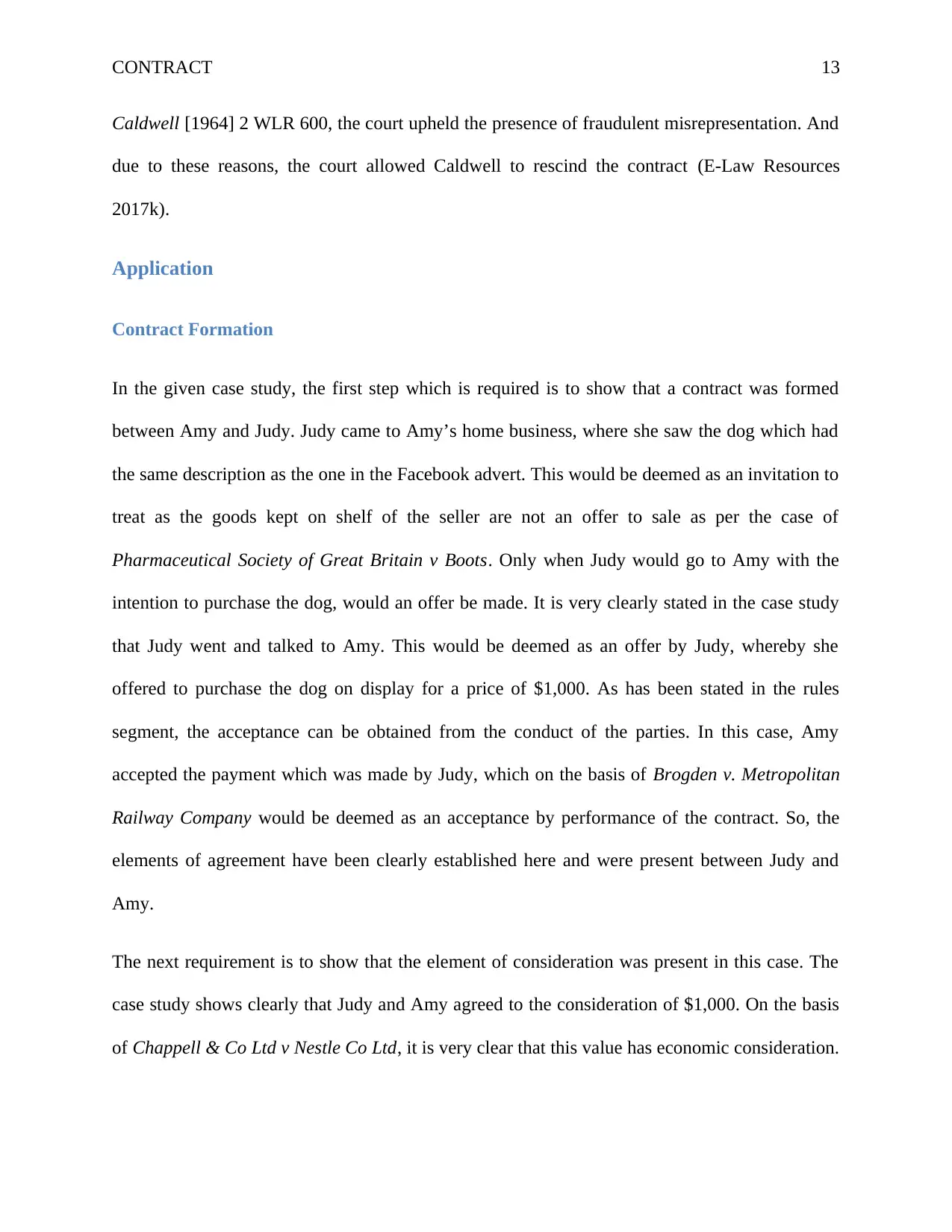
CONTRACT 13
Caldwell [1964] 2 WLR 600, the court upheld the presence of fraudulent misrepresentation. And
due to these reasons, the court allowed Caldwell to rescind the contract (E-Law Resources
2017k).
Application
Contract Formation
In the given case study, the first step which is required is to show that a contract was formed
between Amy and Judy. Judy came to Amy’s home business, where she saw the dog which had
the same description as the one in the Facebook advert. This would be deemed as an invitation to
treat as the goods kept on shelf of the seller are not an offer to sale as per the case of
Pharmaceutical Society of Great Britain v Boots. Only when Judy would go to Amy with the
intention to purchase the dog, would an offer be made. It is very clearly stated in the case study
that Judy went and talked to Amy. This would be deemed as an offer by Judy, whereby she
offered to purchase the dog on display for a price of $1,000. As has been stated in the rules
segment, the acceptance can be obtained from the conduct of the parties. In this case, Amy
accepted the payment which was made by Judy, which on the basis of Brogden v. Metropolitan
Railway Company would be deemed as an acceptance by performance of the contract. So, the
elements of agreement have been clearly established here and were present between Judy and
Amy.
The next requirement is to show that the element of consideration was present in this case. The
case study shows clearly that Judy and Amy agreed to the consideration of $1,000. On the basis
of Chappell & Co Ltd v Nestle Co Ltd, it is very clear that this value has economic consideration.
Caldwell [1964] 2 WLR 600, the court upheld the presence of fraudulent misrepresentation. And
due to these reasons, the court allowed Caldwell to rescind the contract (E-Law Resources
2017k).
Application
Contract Formation
In the given case study, the first step which is required is to show that a contract was formed
between Amy and Judy. Judy came to Amy’s home business, where she saw the dog which had
the same description as the one in the Facebook advert. This would be deemed as an invitation to
treat as the goods kept on shelf of the seller are not an offer to sale as per the case of
Pharmaceutical Society of Great Britain v Boots. Only when Judy would go to Amy with the
intention to purchase the dog, would an offer be made. It is very clearly stated in the case study
that Judy went and talked to Amy. This would be deemed as an offer by Judy, whereby she
offered to purchase the dog on display for a price of $1,000. As has been stated in the rules
segment, the acceptance can be obtained from the conduct of the parties. In this case, Amy
accepted the payment which was made by Judy, which on the basis of Brogden v. Metropolitan
Railway Company would be deemed as an acceptance by performance of the contract. So, the
elements of agreement have been clearly established here and were present between Judy and
Amy.
The next requirement is to show that the element of consideration was present in this case. The
case study shows clearly that Judy and Amy agreed to the consideration of $1,000. On the basis
of Chappell & Co Ltd v Nestle Co Ltd, it is very clear that this value has economic consideration.
Paraphrase This Document
Need a fresh take? Get an instant paraphrase of this document with our AI Paraphraser
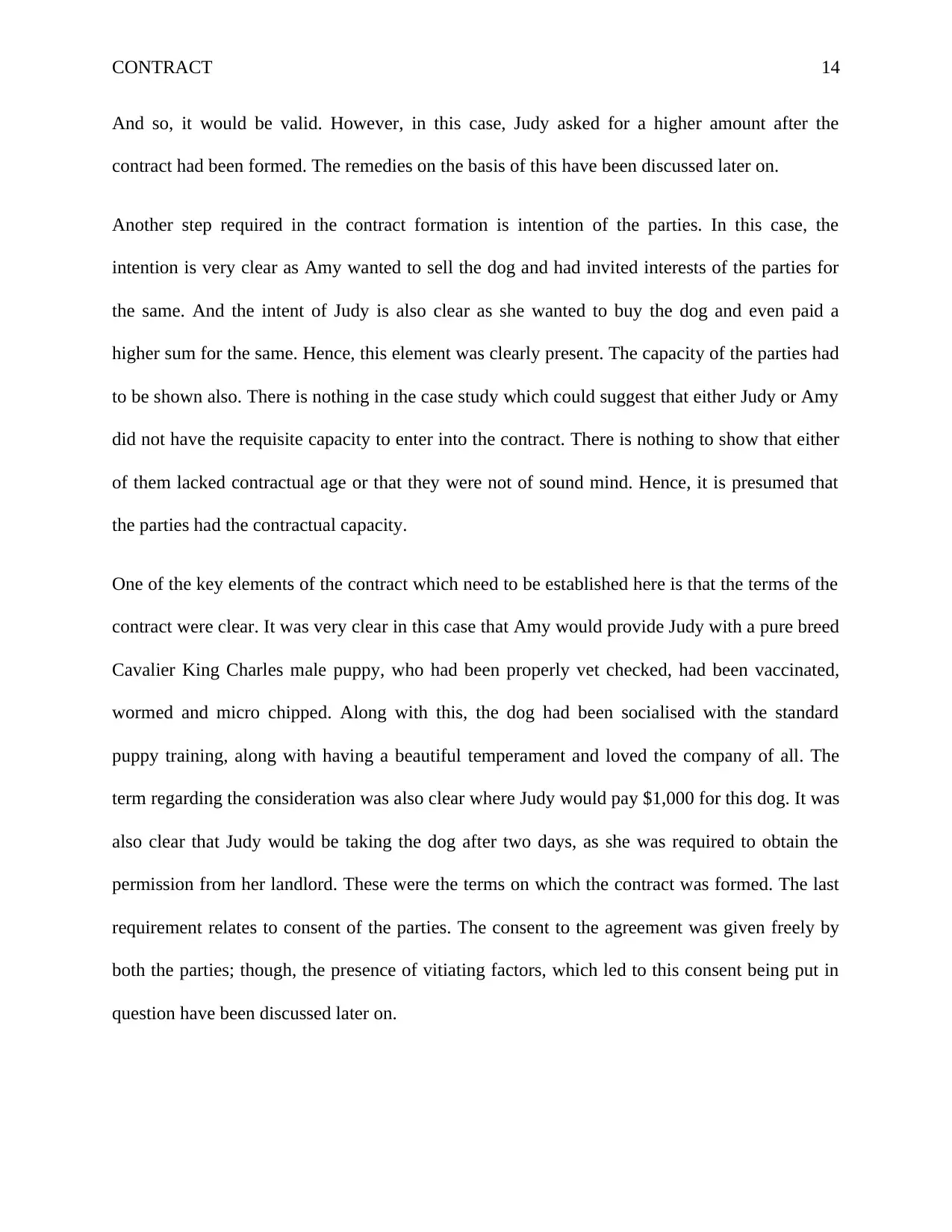
CONTRACT 14
And so, it would be valid. However, in this case, Judy asked for a higher amount after the
contract had been formed. The remedies on the basis of this have been discussed later on.
Another step required in the contract formation is intention of the parties. In this case, the
intention is very clear as Amy wanted to sell the dog and had invited interests of the parties for
the same. And the intent of Judy is also clear as she wanted to buy the dog and even paid a
higher sum for the same. Hence, this element was clearly present. The capacity of the parties had
to be shown also. There is nothing in the case study which could suggest that either Judy or Amy
did not have the requisite capacity to enter into the contract. There is nothing to show that either
of them lacked contractual age or that they were not of sound mind. Hence, it is presumed that
the parties had the contractual capacity.
One of the key elements of the contract which need to be established here is that the terms of the
contract were clear. It was very clear in this case that Amy would provide Judy with a pure breed
Cavalier King Charles male puppy, who had been properly vet checked, had been vaccinated,
wormed and micro chipped. Along with this, the dog had been socialised with the standard
puppy training, along with having a beautiful temperament and loved the company of all. The
term regarding the consideration was also clear where Judy would pay $1,000 for this dog. It was
also clear that Judy would be taking the dog after two days, as she was required to obtain the
permission from her landlord. These were the terms on which the contract was formed. The last
requirement relates to consent of the parties. The consent to the agreement was given freely by
both the parties; though, the presence of vitiating factors, which led to this consent being put in
question have been discussed later on.
And so, it would be valid. However, in this case, Judy asked for a higher amount after the
contract had been formed. The remedies on the basis of this have been discussed later on.
Another step required in the contract formation is intention of the parties. In this case, the
intention is very clear as Amy wanted to sell the dog and had invited interests of the parties for
the same. And the intent of Judy is also clear as she wanted to buy the dog and even paid a
higher sum for the same. Hence, this element was clearly present. The capacity of the parties had
to be shown also. There is nothing in the case study which could suggest that either Judy or Amy
did not have the requisite capacity to enter into the contract. There is nothing to show that either
of them lacked contractual age or that they were not of sound mind. Hence, it is presumed that
the parties had the contractual capacity.
One of the key elements of the contract which need to be established here is that the terms of the
contract were clear. It was very clear in this case that Amy would provide Judy with a pure breed
Cavalier King Charles male puppy, who had been properly vet checked, had been vaccinated,
wormed and micro chipped. Along with this, the dog had been socialised with the standard
puppy training, along with having a beautiful temperament and loved the company of all. The
term regarding the consideration was also clear where Judy would pay $1,000 for this dog. It was
also clear that Judy would be taking the dog after two days, as she was required to obtain the
permission from her landlord. These were the terms on which the contract was formed. The last
requirement relates to consent of the parties. The consent to the agreement was given freely by
both the parties; though, the presence of vitiating factors, which led to this consent being put in
question have been discussed later on.
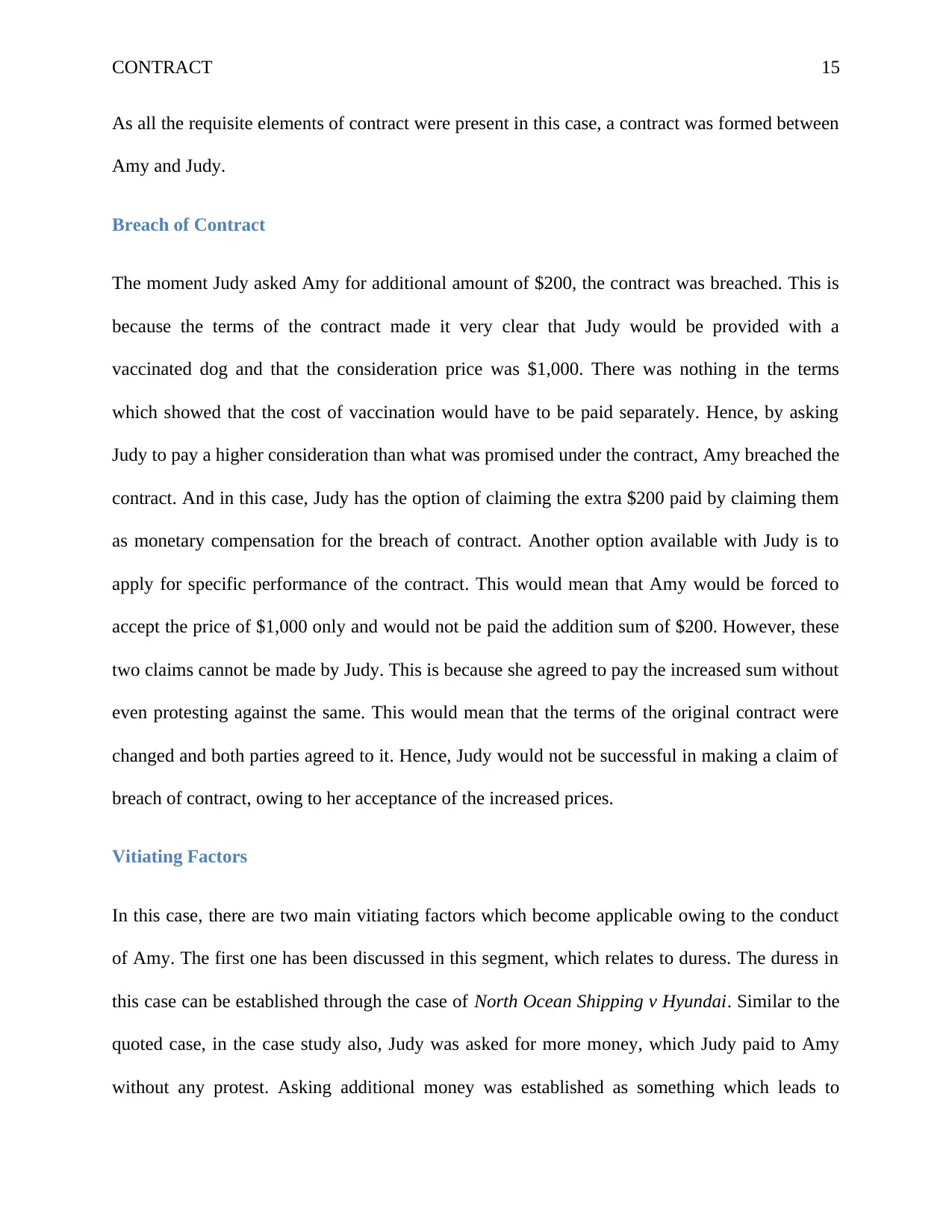
CONTRACT 15
As all the requisite elements of contract were present in this case, a contract was formed between
Amy and Judy.
Breach of Contract
The moment Judy asked Amy for additional amount of $200, the contract was breached. This is
because the terms of the contract made it very clear that Judy would be provided with a
vaccinated dog and that the consideration price was $1,000. There was nothing in the terms
which showed that the cost of vaccination would have to be paid separately. Hence, by asking
Judy to pay a higher consideration than what was promised under the contract, Amy breached the
contract. And in this case, Judy has the option of claiming the extra $200 paid by claiming them
as monetary compensation for the breach of contract. Another option available with Judy is to
apply for specific performance of the contract. This would mean that Amy would be forced to
accept the price of $1,000 only and would not be paid the addition sum of $200. However, these
two claims cannot be made by Judy. This is because she agreed to pay the increased sum without
even protesting against the same. This would mean that the terms of the original contract were
changed and both parties agreed to it. Hence, Judy would not be successful in making a claim of
breach of contract, owing to her acceptance of the increased prices.
Vitiating Factors
In this case, there are two main vitiating factors which become applicable owing to the conduct
of Amy. The first one has been discussed in this segment, which relates to duress. The duress in
this case can be established through the case of North Ocean Shipping v Hyundai. Similar to the
quoted case, in the case study also, Judy was asked for more money, which Judy paid to Amy
without any protest. Asking additional money was established as something which leads to
As all the requisite elements of contract were present in this case, a contract was formed between
Amy and Judy.
Breach of Contract
The moment Judy asked Amy for additional amount of $200, the contract was breached. This is
because the terms of the contract made it very clear that Judy would be provided with a
vaccinated dog and that the consideration price was $1,000. There was nothing in the terms
which showed that the cost of vaccination would have to be paid separately. Hence, by asking
Judy to pay a higher consideration than what was promised under the contract, Amy breached the
contract. And in this case, Judy has the option of claiming the extra $200 paid by claiming them
as monetary compensation for the breach of contract. Another option available with Judy is to
apply for specific performance of the contract. This would mean that Amy would be forced to
accept the price of $1,000 only and would not be paid the addition sum of $200. However, these
two claims cannot be made by Judy. This is because she agreed to pay the increased sum without
even protesting against the same. This would mean that the terms of the original contract were
changed and both parties agreed to it. Hence, Judy would not be successful in making a claim of
breach of contract, owing to her acceptance of the increased prices.
Vitiating Factors
In this case, there are two main vitiating factors which become applicable owing to the conduct
of Amy. The first one has been discussed in this segment, which relates to duress. The duress in
this case can be established through the case of North Ocean Shipping v Hyundai. Similar to the
quoted case, in the case study also, Judy was asked for more money, which Judy paid to Amy
without any protest. Asking additional money was established as something which leads to
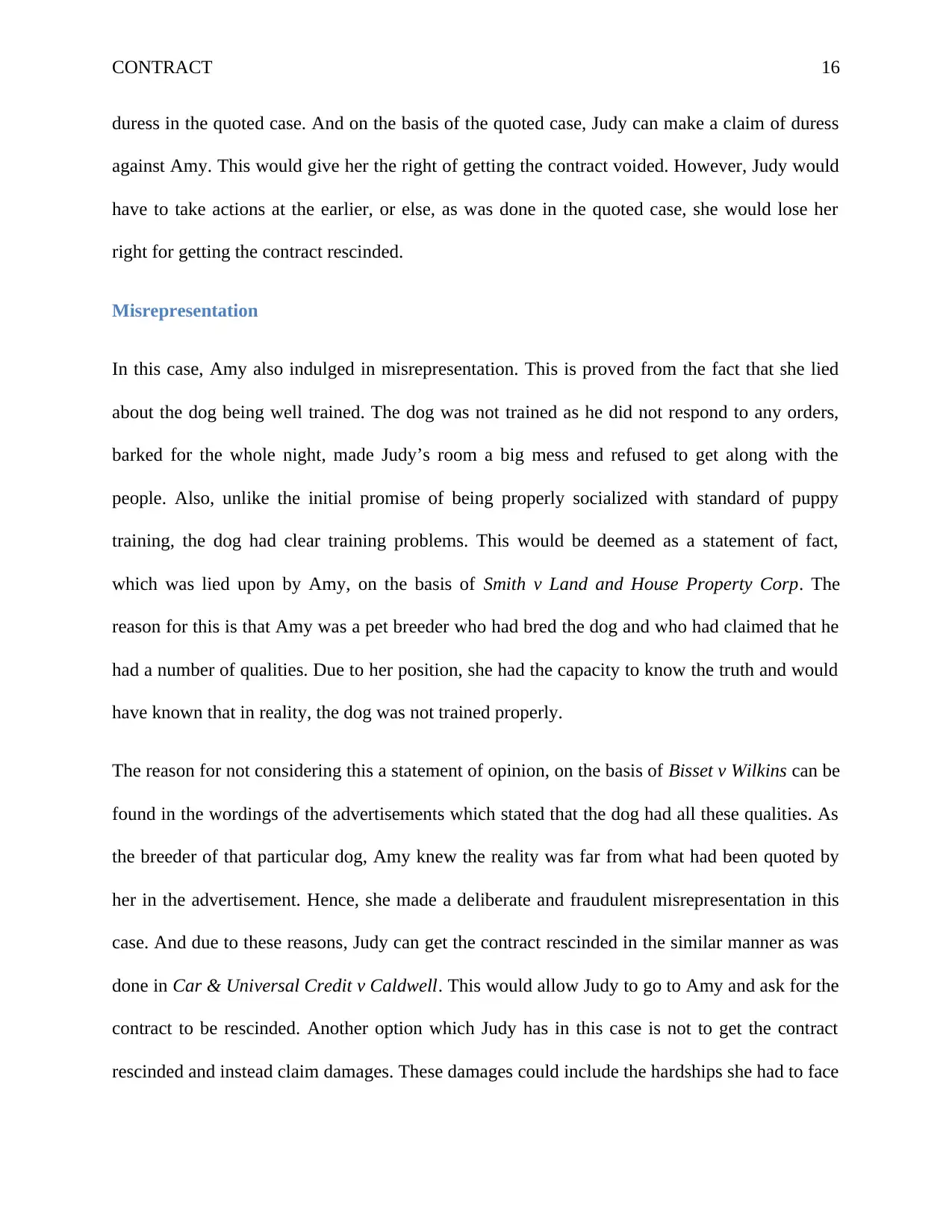
CONTRACT 16
duress in the quoted case. And on the basis of the quoted case, Judy can make a claim of duress
against Amy. This would give her the right of getting the contract voided. However, Judy would
have to take actions at the earlier, or else, as was done in the quoted case, she would lose her
right for getting the contract rescinded.
Misrepresentation
In this case, Amy also indulged in misrepresentation. This is proved from the fact that she lied
about the dog being well trained. The dog was not trained as he did not respond to any orders,
barked for the whole night, made Judy’s room a big mess and refused to get along with the
people. Also, unlike the initial promise of being properly socialized with standard of puppy
training, the dog had clear training problems. This would be deemed as a statement of fact,
which was lied upon by Amy, on the basis of Smith v Land and House Property Corp. The
reason for this is that Amy was a pet breeder who had bred the dog and who had claimed that he
had a number of qualities. Due to her position, she had the capacity to know the truth and would
have known that in reality, the dog was not trained properly.
The reason for not considering this a statement of opinion, on the basis of Bisset v Wilkins can be
found in the wordings of the advertisements which stated that the dog had all these qualities. As
the breeder of that particular dog, Amy knew the reality was far from what had been quoted by
her in the advertisement. Hence, she made a deliberate and fraudulent misrepresentation in this
case. And due to these reasons, Judy can get the contract rescinded in the similar manner as was
done in Car & Universal Credit v Caldwell. This would allow Judy to go to Amy and ask for the
contract to be rescinded. Another option which Judy has in this case is not to get the contract
rescinded and instead claim damages. These damages could include the hardships she had to face
duress in the quoted case. And on the basis of the quoted case, Judy can make a claim of duress
against Amy. This would give her the right of getting the contract voided. However, Judy would
have to take actions at the earlier, or else, as was done in the quoted case, she would lose her
right for getting the contract rescinded.
Misrepresentation
In this case, Amy also indulged in misrepresentation. This is proved from the fact that she lied
about the dog being well trained. The dog was not trained as he did not respond to any orders,
barked for the whole night, made Judy’s room a big mess and refused to get along with the
people. Also, unlike the initial promise of being properly socialized with standard of puppy
training, the dog had clear training problems. This would be deemed as a statement of fact,
which was lied upon by Amy, on the basis of Smith v Land and House Property Corp. The
reason for this is that Amy was a pet breeder who had bred the dog and who had claimed that he
had a number of qualities. Due to her position, she had the capacity to know the truth and would
have known that in reality, the dog was not trained properly.
The reason for not considering this a statement of opinion, on the basis of Bisset v Wilkins can be
found in the wordings of the advertisements which stated that the dog had all these qualities. As
the breeder of that particular dog, Amy knew the reality was far from what had been quoted by
her in the advertisement. Hence, she made a deliberate and fraudulent misrepresentation in this
case. And due to these reasons, Judy can get the contract rescinded in the similar manner as was
done in Car & Universal Credit v Caldwell. This would allow Judy to go to Amy and ask for the
contract to be rescinded. Another option which Judy has in this case is not to get the contract
rescinded and instead claim damages. These damages could include the hardships she had to face
Secure Best Marks with AI Grader
Need help grading? Try our AI Grader for instant feedback on your assignments.
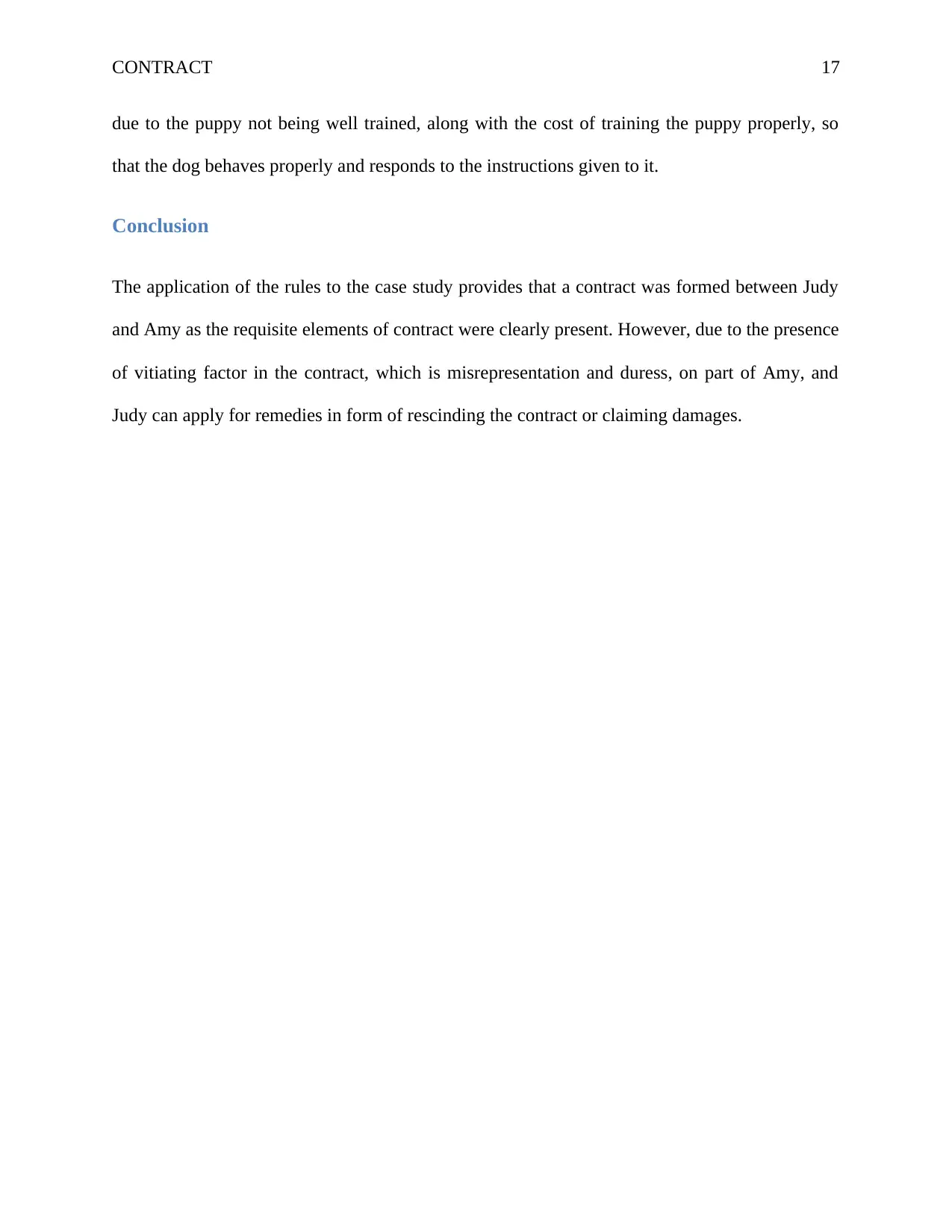
CONTRACT 17
due to the puppy not being well trained, along with the cost of training the puppy properly, so
that the dog behaves properly and responds to the instructions given to it.
Conclusion
The application of the rules to the case study provides that a contract was formed between Judy
and Amy as the requisite elements of contract were clearly present. However, due to the presence
of vitiating factor in the contract, which is misrepresentation and duress, on part of Amy, and
Judy can apply for remedies in form of rescinding the contract or claiming damages.
due to the puppy not being well trained, along with the cost of training the puppy properly, so
that the dog behaves properly and responds to the instructions given to it.
Conclusion
The application of the rules to the case study provides that a contract was formed between Judy
and Amy as the requisite elements of contract were clearly present. However, due to the presence
of vitiating factor in the contract, which is misrepresentation and duress, on part of Amy, and
Judy can apply for remedies in form of rescinding the contract or claiming damages.
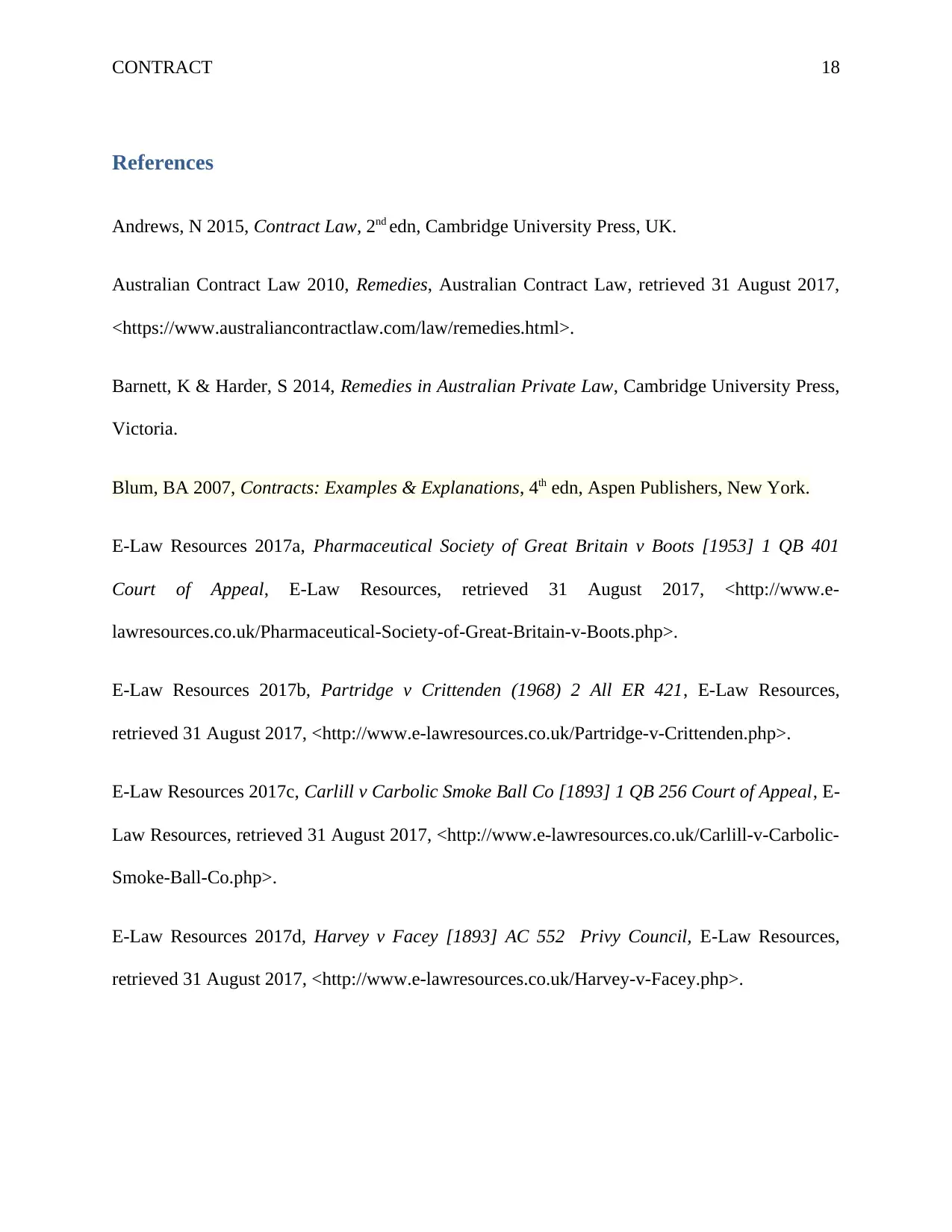
CONTRACT 18
References
Andrews, N 2015, Contract Law, 2nd edn, Cambridge University Press, UK.
Australian Contract Law 2010, Remedies, Australian Contract Law, retrieved 31 August 2017,
<https://www.australiancontractlaw.com/law/remedies.html>.
Barnett, K & Harder, S 2014, Remedies in Australian Private Law, Cambridge University Press,
Victoria.
Blum, BA 2007, Contracts: Examples & Explanations, 4th edn, Aspen Publishers, New York.
E-Law Resources 2017a, Pharmaceutical Society of Great Britain v Boots [1953] 1 QB 401
Court of Appeal, E-Law Resources, retrieved 31 August 2017, <http://www.e-
lawresources.co.uk/Pharmaceutical-Society-of-Great-Britain-v-Boots.php>.
E-Law Resources 2017b, Partridge v Crittenden (1968) 2 All ER 421, E-Law Resources,
retrieved 31 August 2017, <http://www.e-lawresources.co.uk/Partridge-v-Crittenden.php>.
E-Law Resources 2017c, Carlill v Carbolic Smoke Ball Co [1893] 1 QB 256 Court of Appeal, E-
Law Resources, retrieved 31 August 2017, <http://www.e-lawresources.co.uk/Carlill-v-Carbolic-
Smoke-Ball-Co.php>.
E-Law Resources 2017d, Harvey v Facey [1893] AC 552 Privy Council, E-Law Resources,
retrieved 31 August 2017, <http://www.e-lawresources.co.uk/Harvey-v-Facey.php>.
References
Andrews, N 2015, Contract Law, 2nd edn, Cambridge University Press, UK.
Australian Contract Law 2010, Remedies, Australian Contract Law, retrieved 31 August 2017,
<https://www.australiancontractlaw.com/law/remedies.html>.
Barnett, K & Harder, S 2014, Remedies in Australian Private Law, Cambridge University Press,
Victoria.
Blum, BA 2007, Contracts: Examples & Explanations, 4th edn, Aspen Publishers, New York.
E-Law Resources 2017a, Pharmaceutical Society of Great Britain v Boots [1953] 1 QB 401
Court of Appeal, E-Law Resources, retrieved 31 August 2017, <http://www.e-
lawresources.co.uk/Pharmaceutical-Society-of-Great-Britain-v-Boots.php>.
E-Law Resources 2017b, Partridge v Crittenden (1968) 2 All ER 421, E-Law Resources,
retrieved 31 August 2017, <http://www.e-lawresources.co.uk/Partridge-v-Crittenden.php>.
E-Law Resources 2017c, Carlill v Carbolic Smoke Ball Co [1893] 1 QB 256 Court of Appeal, E-
Law Resources, retrieved 31 August 2017, <http://www.e-lawresources.co.uk/Carlill-v-Carbolic-
Smoke-Ball-Co.php>.
E-Law Resources 2017d, Harvey v Facey [1893] AC 552 Privy Council, E-Law Resources,
retrieved 31 August 2017, <http://www.e-lawresources.co.uk/Harvey-v-Facey.php>.
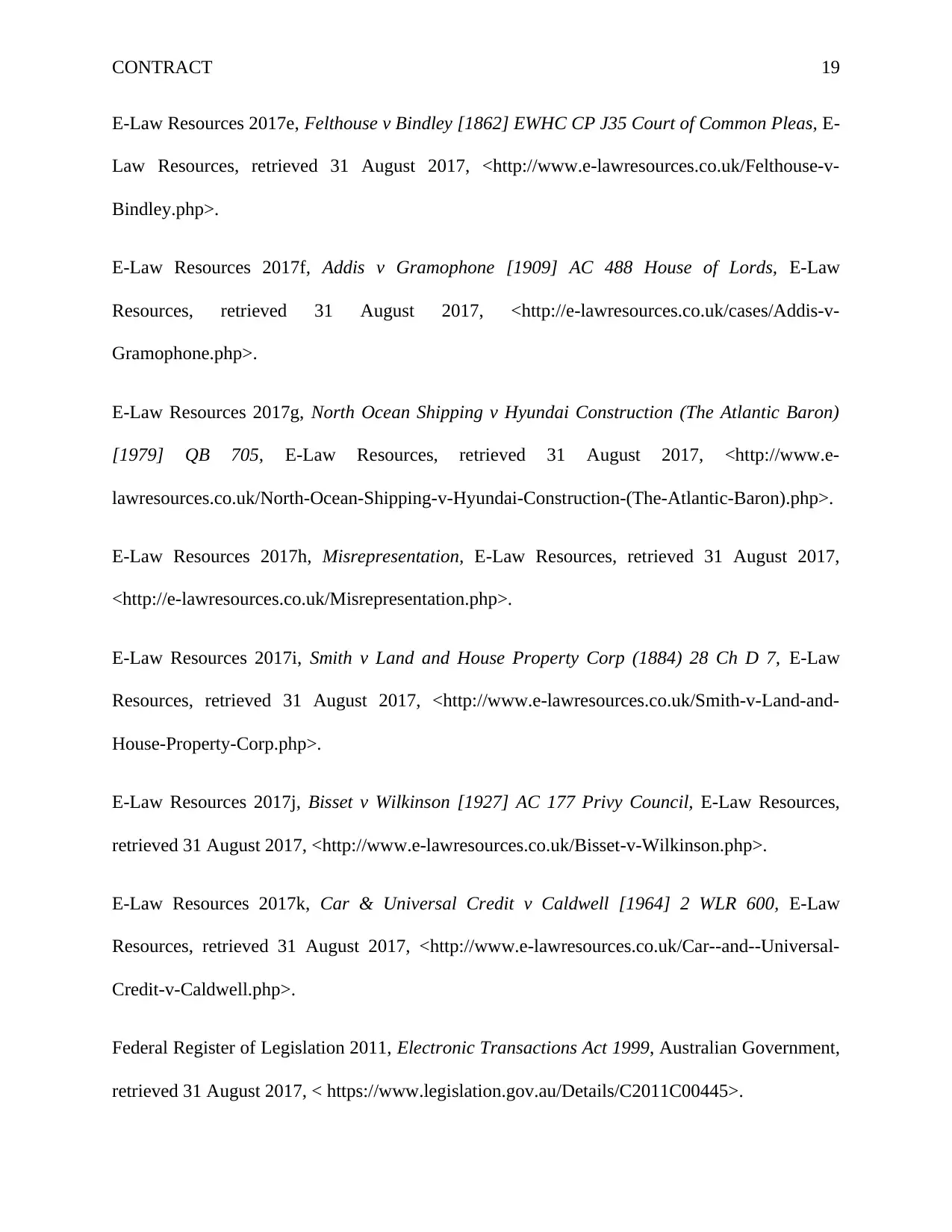
CONTRACT 19
E-Law Resources 2017e, Felthouse v Bindley [1862] EWHC CP J35 Court of Common Pleas, E-
Law Resources, retrieved 31 August 2017, <http://www.e-lawresources.co.uk/Felthouse-v-
Bindley.php>.
E-Law Resources 2017f, Addis v Gramophone [1909] AC 488 House of Lords, E-Law
Resources, retrieved 31 August 2017, <http://e-lawresources.co.uk/cases/Addis-v-
Gramophone.php>.
E-Law Resources 2017g, North Ocean Shipping v Hyundai Construction (The Atlantic Baron)
[1979] QB 705, E-Law Resources, retrieved 31 August 2017, <http://www.e-
lawresources.co.uk/North-Ocean-Shipping-v-Hyundai-Construction-(The-Atlantic-Baron).php>.
E-Law Resources 2017h, Misrepresentation, E-Law Resources, retrieved 31 August 2017,
<http://e-lawresources.co.uk/Misrepresentation.php>.
E-Law Resources 2017i, Smith v Land and House Property Corp (1884) 28 Ch D 7, E-Law
Resources, retrieved 31 August 2017, <http://www.e-lawresources.co.uk/Smith-v-Land-and-
House-Property-Corp.php>.
E-Law Resources 2017j, Bisset v Wilkinson [1927] AC 177 Privy Council, E-Law Resources,
retrieved 31 August 2017, <http://www.e-lawresources.co.uk/Bisset-v-Wilkinson.php>.
E-Law Resources 2017k, Car & Universal Credit v Caldwell [1964] 2 WLR 600, E-Law
Resources, retrieved 31 August 2017, <http://www.e-lawresources.co.uk/Car--and--Universal-
Credit-v-Caldwell.php>.
Federal Register of Legislation 2011, Electronic Transactions Act 1999, Australian Government,
retrieved 31 August 2017, < https://www.legislation.gov.au/Details/C2011C00445>.
E-Law Resources 2017e, Felthouse v Bindley [1862] EWHC CP J35 Court of Common Pleas, E-
Law Resources, retrieved 31 August 2017, <http://www.e-lawresources.co.uk/Felthouse-v-
Bindley.php>.
E-Law Resources 2017f, Addis v Gramophone [1909] AC 488 House of Lords, E-Law
Resources, retrieved 31 August 2017, <http://e-lawresources.co.uk/cases/Addis-v-
Gramophone.php>.
E-Law Resources 2017g, North Ocean Shipping v Hyundai Construction (The Atlantic Baron)
[1979] QB 705, E-Law Resources, retrieved 31 August 2017, <http://www.e-
lawresources.co.uk/North-Ocean-Shipping-v-Hyundai-Construction-(The-Atlantic-Baron).php>.
E-Law Resources 2017h, Misrepresentation, E-Law Resources, retrieved 31 August 2017,
<http://e-lawresources.co.uk/Misrepresentation.php>.
E-Law Resources 2017i, Smith v Land and House Property Corp (1884) 28 Ch D 7, E-Law
Resources, retrieved 31 August 2017, <http://www.e-lawresources.co.uk/Smith-v-Land-and-
House-Property-Corp.php>.
E-Law Resources 2017j, Bisset v Wilkinson [1927] AC 177 Privy Council, E-Law Resources,
retrieved 31 August 2017, <http://www.e-lawresources.co.uk/Bisset-v-Wilkinson.php>.
E-Law Resources 2017k, Car & Universal Credit v Caldwell [1964] 2 WLR 600, E-Law
Resources, retrieved 31 August 2017, <http://www.e-lawresources.co.uk/Car--and--Universal-
Credit-v-Caldwell.php>.
Federal Register of Legislation 2011, Electronic Transactions Act 1999, Australian Government,
retrieved 31 August 2017, < https://www.legislation.gov.au/Details/C2011C00445>.
Paraphrase This Document
Need a fresh take? Get an instant paraphrase of this document with our AI Paraphraser
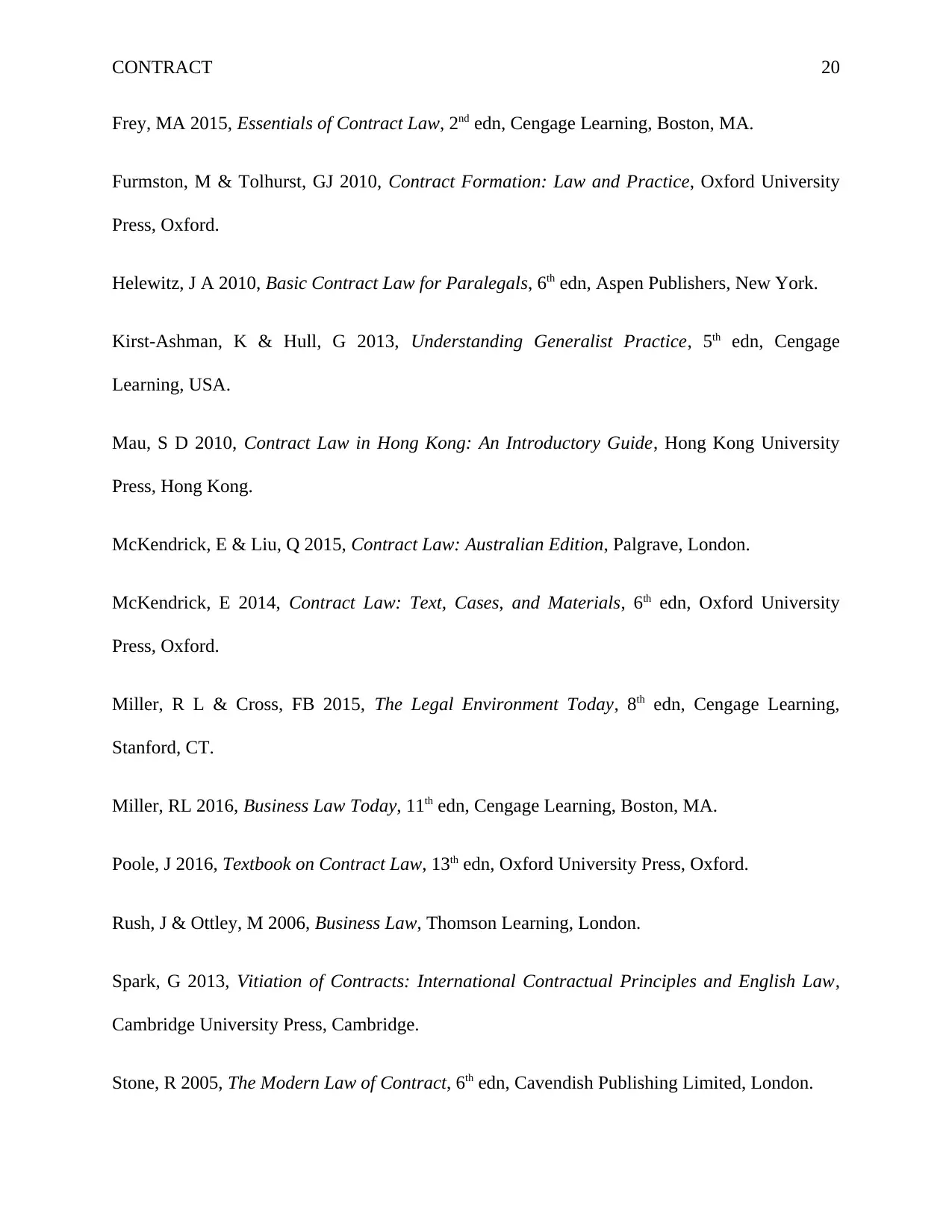
CONTRACT 20
Frey, MA 2015, Essentials of Contract Law, 2nd edn, Cengage Learning, Boston, MA.
Furmston, M & Tolhurst, GJ 2010, Contract Formation: Law and Practice, Oxford University
Press, Oxford.
Helewitz, J A 2010, Basic Contract Law for Paralegals, 6th edn, Aspen Publishers, New York.
Kirst-Ashman, K & Hull, G 2013, Understanding Generalist Practice, 5th edn, Cengage
Learning, USA.
Mau, S D 2010, Contract Law in Hong Kong: An Introductory Guide, Hong Kong University
Press, Hong Kong.
McKendrick, E & Liu, Q 2015, Contract Law: Australian Edition, Palgrave, London.
McKendrick, E 2014, Contract Law: Text, Cases, and Materials, 6th edn, Oxford University
Press, Oxford.
Miller, R L & Cross, FB 2015, The Legal Environment Today, 8th edn, Cengage Learning,
Stanford, CT.
Miller, RL 2016, Business Law Today, 11th edn, Cengage Learning, Boston, MA.
Poole, J 2016, Textbook on Contract Law, 13th edn, Oxford University Press, Oxford.
Rush, J & Ottley, M 2006, Business Law, Thomson Learning, London.
Spark, G 2013, Vitiation of Contracts: International Contractual Principles and English Law,
Cambridge University Press, Cambridge.
Stone, R 2005, The Modern Law of Contract, 6th edn, Cavendish Publishing Limited, London.
Frey, MA 2015, Essentials of Contract Law, 2nd edn, Cengage Learning, Boston, MA.
Furmston, M & Tolhurst, GJ 2010, Contract Formation: Law and Practice, Oxford University
Press, Oxford.
Helewitz, J A 2010, Basic Contract Law for Paralegals, 6th edn, Aspen Publishers, New York.
Kirst-Ashman, K & Hull, G 2013, Understanding Generalist Practice, 5th edn, Cengage
Learning, USA.
Mau, S D 2010, Contract Law in Hong Kong: An Introductory Guide, Hong Kong University
Press, Hong Kong.
McKendrick, E & Liu, Q 2015, Contract Law: Australian Edition, Palgrave, London.
McKendrick, E 2014, Contract Law: Text, Cases, and Materials, 6th edn, Oxford University
Press, Oxford.
Miller, R L & Cross, FB 2015, The Legal Environment Today, 8th edn, Cengage Learning,
Stanford, CT.
Miller, RL 2016, Business Law Today, 11th edn, Cengage Learning, Boston, MA.
Poole, J 2016, Textbook on Contract Law, 13th edn, Oxford University Press, Oxford.
Rush, J & Ottley, M 2006, Business Law, Thomson Learning, London.
Spark, G 2013, Vitiation of Contracts: International Contractual Principles and English Law,
Cambridge University Press, Cambridge.
Stone, R 2005, The Modern Law of Contract, 6th edn, Cavendish Publishing Limited, London.
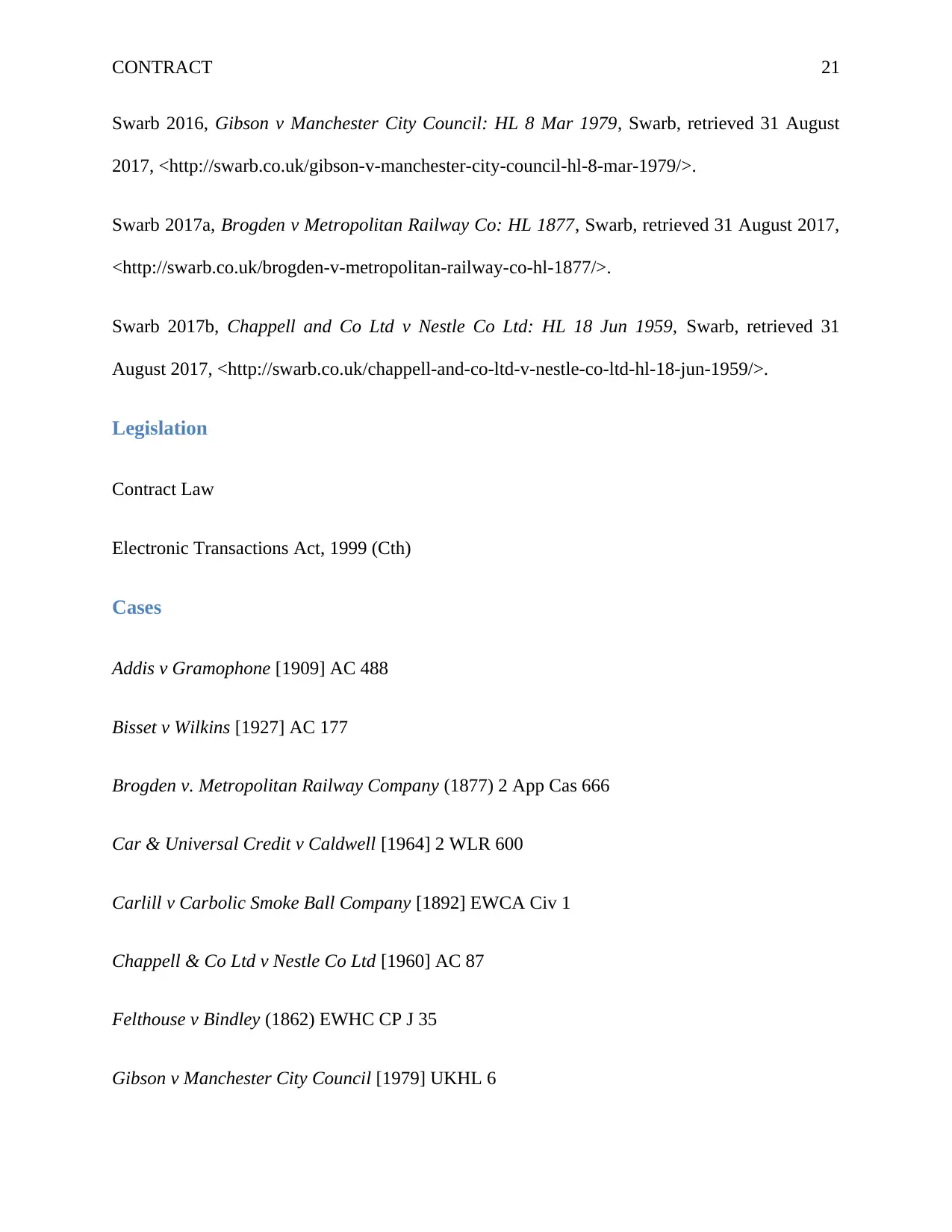
CONTRACT 21
Swarb 2016, Gibson v Manchester City Council: HL 8 Mar 1979, Swarb, retrieved 31 August
2017, <http://swarb.co.uk/gibson-v-manchester-city-council-hl-8-mar-1979/>.
Swarb 2017a, Brogden v Metropolitan Railway Co: HL 1877, Swarb, retrieved 31 August 2017,
<http://swarb.co.uk/brogden-v-metropolitan-railway-co-hl-1877/>.
Swarb 2017b, Chappell and Co Ltd v Nestle Co Ltd: HL 18 Jun 1959, Swarb, retrieved 31
August 2017, <http://swarb.co.uk/chappell-and-co-ltd-v-nestle-co-ltd-hl-18-jun-1959/>.
Legislation
Contract Law
Electronic Transactions Act, 1999 (Cth)
Cases
Addis v Gramophone [1909] AC 488
Bisset v Wilkins [1927] AC 177
Brogden v. Metropolitan Railway Company (1877) 2 App Cas 666
Car & Universal Credit v Caldwell [1964] 2 WLR 600
Carlill v Carbolic Smoke Ball Company [1892] EWCA Civ 1
Chappell & Co Ltd v Nestle Co Ltd [1960] AC 87
Felthouse v Bindley (1862) EWHC CP J 35
Gibson v Manchester City Council [1979] UKHL 6
Swarb 2016, Gibson v Manchester City Council: HL 8 Mar 1979, Swarb, retrieved 31 August
2017, <http://swarb.co.uk/gibson-v-manchester-city-council-hl-8-mar-1979/>.
Swarb 2017a, Brogden v Metropolitan Railway Co: HL 1877, Swarb, retrieved 31 August 2017,
<http://swarb.co.uk/brogden-v-metropolitan-railway-co-hl-1877/>.
Swarb 2017b, Chappell and Co Ltd v Nestle Co Ltd: HL 18 Jun 1959, Swarb, retrieved 31
August 2017, <http://swarb.co.uk/chappell-and-co-ltd-v-nestle-co-ltd-hl-18-jun-1959/>.
Legislation
Contract Law
Electronic Transactions Act, 1999 (Cth)
Cases
Addis v Gramophone [1909] AC 488
Bisset v Wilkins [1927] AC 177
Brogden v. Metropolitan Railway Company (1877) 2 App Cas 666
Car & Universal Credit v Caldwell [1964] 2 WLR 600
Carlill v Carbolic Smoke Ball Company [1892] EWCA Civ 1
Chappell & Co Ltd v Nestle Co Ltd [1960] AC 87
Felthouse v Bindley (1862) EWHC CP J 35
Gibson v Manchester City Council [1979] UKHL 6
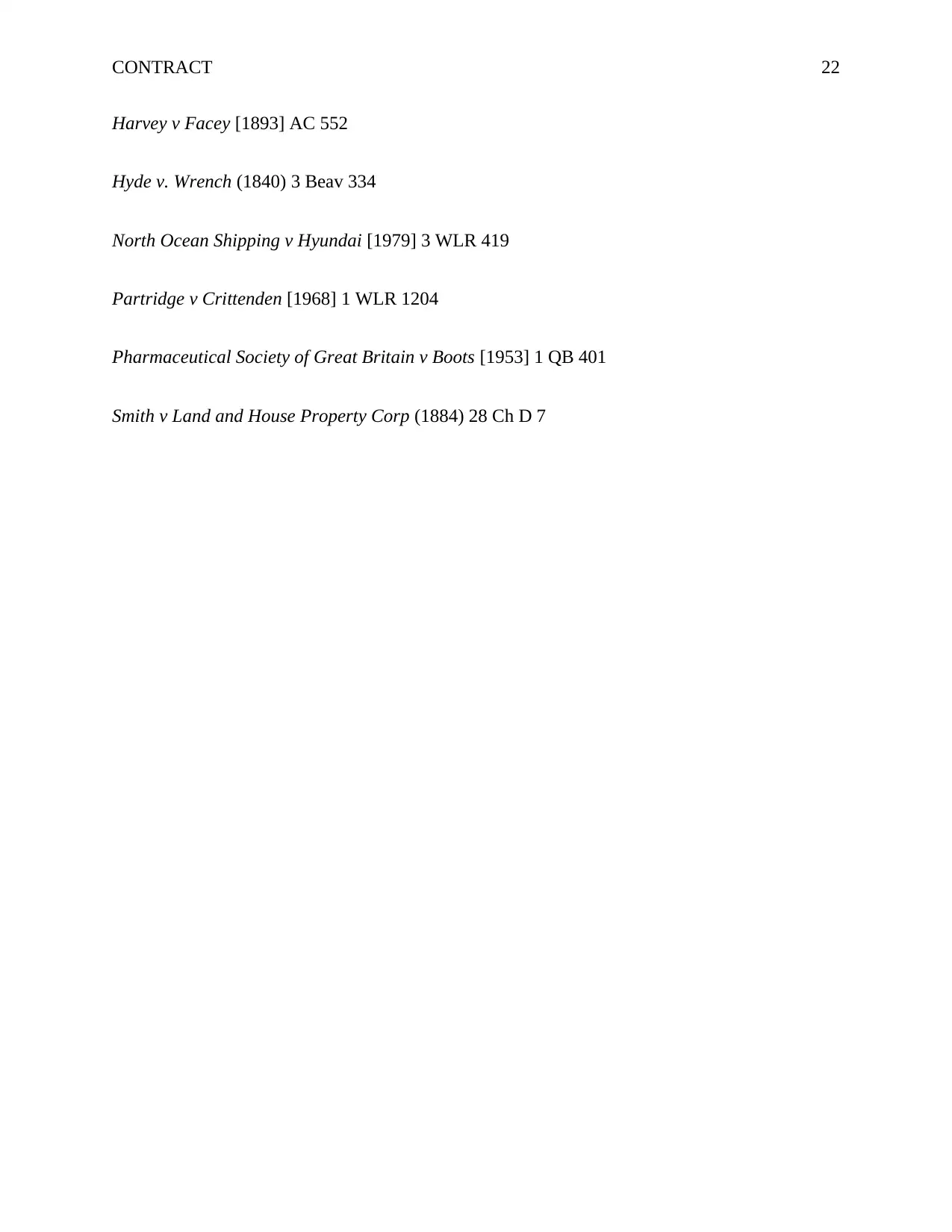
CONTRACT 22
Harvey v Facey [1893] AC 552
Hyde v. Wrench (1840) 3 Beav 334
North Ocean Shipping v Hyundai [1979] 3 WLR 419
Partridge v Crittenden [1968] 1 WLR 1204
Pharmaceutical Society of Great Britain v Boots [1953] 1 QB 401
Smith v Land and House Property Corp (1884) 28 Ch D 7
Harvey v Facey [1893] AC 552
Hyde v. Wrench (1840) 3 Beav 334
North Ocean Shipping v Hyundai [1979] 3 WLR 419
Partridge v Crittenden [1968] 1 WLR 1204
Pharmaceutical Society of Great Britain v Boots [1953] 1 QB 401
Smith v Land and House Property Corp (1884) 28 Ch D 7
1 out of 22
Related Documents
Your All-in-One AI-Powered Toolkit for Academic Success.
+13062052269
info@desklib.com
Available 24*7 on WhatsApp / Email
![[object Object]](/_next/static/media/star-bottom.7253800d.svg)
Unlock your academic potential
© 2024 | Zucol Services PVT LTD | All rights reserved.





